The Design Gallery
www.designgallery.co.uk
The highly active dealers in Art Deco and Arts and Crafts items including furniture, lighting, metalware and many other items as well as a large offering of 20C costume jewellery.
Their beautiful gallery at 5 The Green, Westerham, Kent TN16 1AS Tel 01959 561234 is easily reached off the M25. A 2000ft warehouse is also available to see by appointment.
Look out for them at Eltham Palace Art Deco fair and their exhibitions and warehouse open days are much in demand. www.designgallery.co.uk
ART
DECO ORIGINALS FOR SALE
We
will list Art Deco originals FREE of
charge for our clients. We will charge 10% for any sales generated.
We
will list Art Deco Furniture, Mirrors, Lighting, Ceramics
and Glass, Bronze Figures, Textiles & Carpets, Clocks,
Jewellery and metalware.
Please
EMAIL
for details.
FOR
ART DECO ACCESSORIES AND INTERIORS, VISIT 'THE
ART DECO HOME'
On
this page you will find a selection of Art Deco originals.
Please scroll down the page to see a selection of original
Clarice Cliff ceramics. We can send full condition reports
and additional images upon request.
FURNITURE
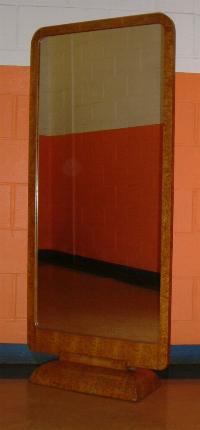
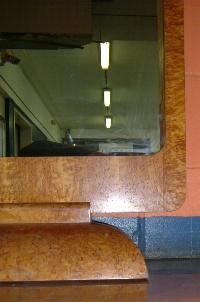
ART
DECO CHEVAL MIRROR
Beautiful
quality Art Deco dressing mirror, in blond burr elm. The reverse
of the mirror is also veneered.
Height
1.640, Width 0.720, Depth 0.270
Price
SOLD (ADF2)
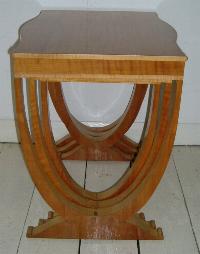
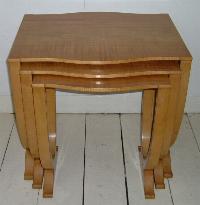
ART DECO NEST OF TABLES
Fine quality nest of 3 Art Deco tables, in sycamore and satinwood,
made by the Token Works.
Height 0.560, Width 0.610, Depth 0.470 (largest table)
Price SOLD (ADF1)
ART DECO BRONZES & SCULPTURE
COMING SOON!
ART
DECO CERAMICS
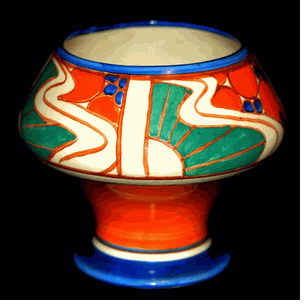
SUNRISE Vase by Clarice Cliff in the Sunrise pattern
and shape# 341. Excellent condition. No damage or restoration.
Size 5 inches tall and 19 inches around the widest part. Signed
"Fantasque by Clarice Cliff". Price £775/$1525.
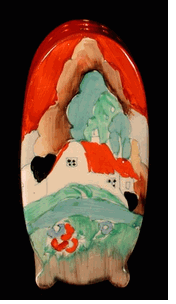
FOREST GLEN Sugar Sifter by Clarice Cliff in the Forest
Glen pattern and Bonjour shape. Size is 5 inches tall. Minor
stress line underneath were red cork fits. Only marked "Newport
Pottery England". Price £565/$1149.
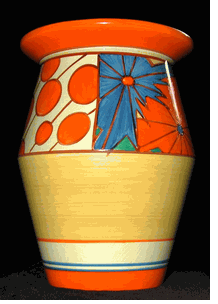
UMBRELLAS & RAIN Shape 342 Vase in the Umbrella
& Rain pattern. Size is 8 inches tall. Nicely painted
and banded. Back-stamp is Fantasque by Clarice Cliff in large
handwritten script. Invisibly repaired chip to rim. Price
£625/$1225.
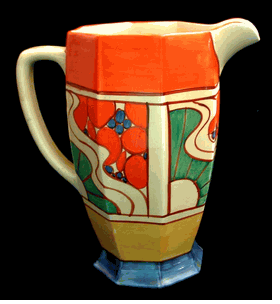
SUNRISE Athens Jug/Pitcher in the Sunrise pattern.
This is the largest size at 8 inches tall. No damage or restoration.
Back-stamp is Fantasque by Clarice Cliff in large handwritten
script. Size number 24. Price £745/$1450.
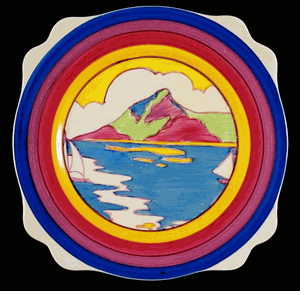
GIBRALTAR Large Leda shape plate in the Gibraltar
pattern. Size is 9.5 inches wide. No damage or restoration.
Couple of minor utensil marks. Back-stamp is Fantasque Bizarre
by Clarice Cliff. Price £545/$1055.
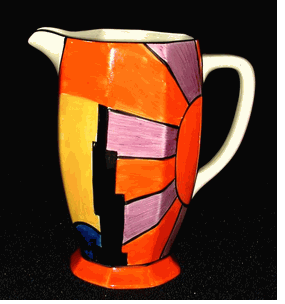
SUNRAY Athens Jug/Pitcher in the Sunray pattern. Excellent
condition. No damage or restoration. Size is 6 inches high.
Size number 42. Signed "Bizarre by Clarice Cliff".
Price £895/$1745.
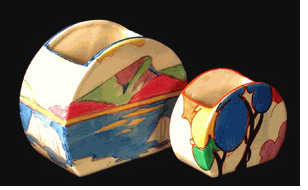
GIBRALTAR Bowl by Clarice Cliff in the Gibraltar pattern.
This is the larger size bowl and is pictured next to the smaller
size of this shape. Size of this piece is 4.5 inches wide
by 3.75 tall. No damage or restoration. Signed Bizarre by
Clarice Cliff. 5 yachts on the pattern. Price £565/$1095.
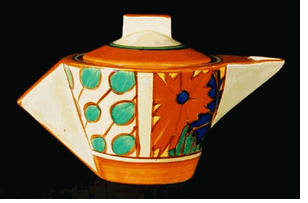
Umbrellas & Rain Conical Teapot by Clarice Cliff
in the Umbrellas & Rain pattern. Signed "Fantasque
by Clarice Cliff". Size 4.5 inches tall by 7 inches wide.
This is the smaller size Conical Teapot. Slight repair to
inner rim of lid. Price £565/$1095.
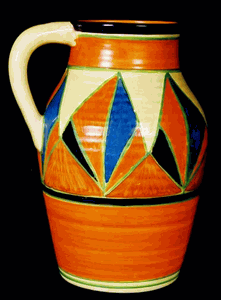
ORIGINAL BIZARRE Lotus jug by Clarice Cliff in an
Original Bizarre pattern. Size is 11 inches tall. Signed "Bizarre
by Clarice Cliff" in large handwritten Script. Also has
"Lotus/Shape" and "Reg 668241" impressed
on the base. Dates to about 1928. No damage or restoration.
Has had some repaint to the Blue and Purple. See the matching
Bowl on the £200 to £300 page. Price £645/$1250.
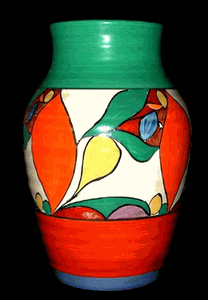
WHISPER ISIS VASE Vase by Clarice Cliff in the Whisper
pattern and Isis shape. Size is 10 inches tall. Excellent
condition. Signed "Bizarre by Clarice Cliff" in
large script. Price £895/$1745.
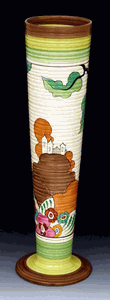
ALTON Very tall Vase in the Alton pattern. Signed
"Bizarre by Clarice Cliff". Size is a massive 18.5
inches tall. No damage or restoration. Condition is superb.
Price £1350/$2635.
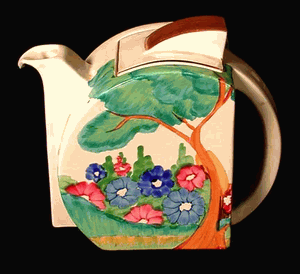
FRAGRANCE Stamford Teapot in the Fragrance pattern.
c1935. Size 6 inches tall. Nicely painted. Good condition.
Only flaw is a factory grind to underneath of the spout, which
I am having re-glazed. Signed "Bizarre by Clarice Cliff".
Price £850/$1650.
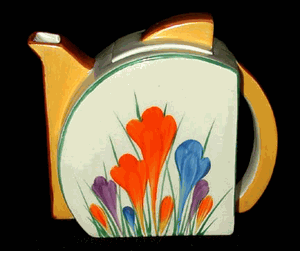
CROCUS STAMFORD Teapot by Clarice Cliff in the Crocus
pattern and Stamford shape. Has the early Angular spout (later
refined into the Teardrop shape). Excellent condition. No
damage or restoration. Paintwork is excellent. Size 4.5 inches
tall. Couple of very small circular firing flaws to the top.
Signed "Bizarre by Clarice Cliff". Price £685/$1265.
SOLD.
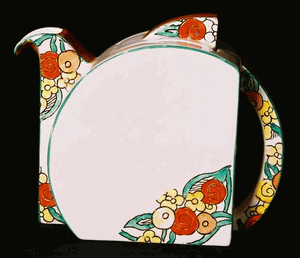
Stamford Teapot Stamford shape Teapot in the Stamford
pattern. Size 4.5 inches tall. No damage or restoration. Signed
"Bizarre by Clarice Cliff". From the early 1930's.
Price £545/$1050.
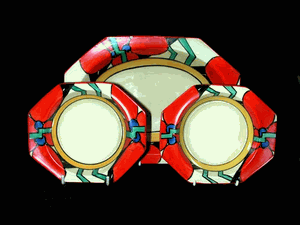
RED PICASSO FLOWER Serving Bowl (10.5 inches) and
two smaller bowls (6 inches) in the Red Picasso pattern. Excellent
condition. Painting is truly superb. Each has "Bizarre
by Clarice Cliff" back-stamp. Larger Bowl SOLD. Small
bowls £265/$515 each.
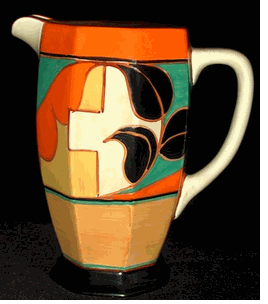
Feather & Leaves Athens Jug/Pitcher in the Feather
and Leaves pattern. Size 7 inches high. Superb condition.
No damage or restoration. Signed "Fantasque by Clarice
Cliff". Price £775/$1500.
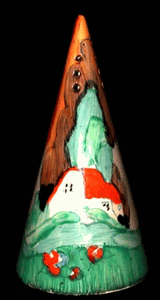
FOREST GLEN Conical Sugar Sifter in the Forest Glen
pattern. Size 5.5 inches high. Very nicely painted. No restoration.
Couple of minor nicks to the underside of the base. Signed
"Clarice Cliff". Price £1100/$2145.
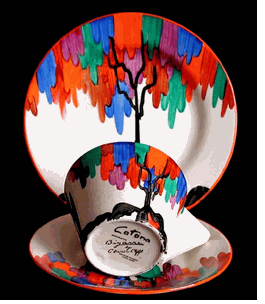
LATONA TREE Conical Trio cup/saucer/plate) in the
Latona Tree pattern. Plate 7 inches wide. Excellent condition.
No damage or restoration. Signed "Clarice Cliff"
and "Bizarre". Price £695/$1345.
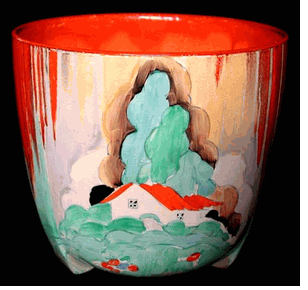
FOREST GLEN Large Jardiniere by Clarice Cliff in the
Forest Glen pattern. Size 7 inches tall and 7.5 inches wide.
Excellent condition. No damage or restoration. Signed "Clarice
Cliff". Being very critical slight rubbing to the inside.
Price £965/$1875.
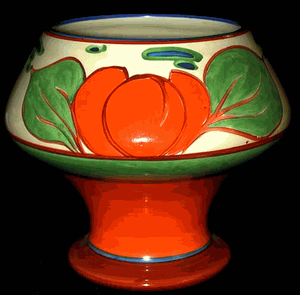
ORANGE LILY Vase by Clarice Cliff in the Orange Lily
pattern and shape# 341. Excellent condition. No damage or
restoration. Size 5 inches tall and 19 inches around the widest
part. Signed "Fantasque by Clarice Cliff". Price
£725/$1400
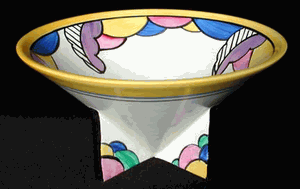
LATONA CONICAL Conical Bowl in a Latona pattern. Size
7.5 inches wide. No damage or restoration. Bit of paint loss
to one of the blue "pendants". Signed "Clarice
Cliff" and "Bizarre". Price £765/$1485.
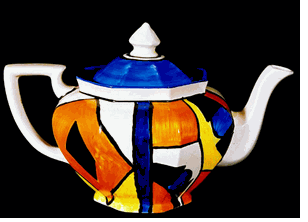
DIAMONDS A superb Teapot in the Athens shape and Diamonds
pattern. This is the large Athens Teapot (size number 24).
Excellent condition. Signed in large Script "Bizarre
by Clarice Cliff". Price £1250/$2435.
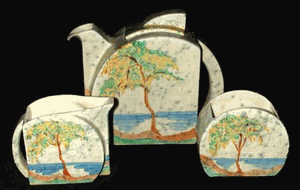
PATINA Stamford shape Teapot, Milk and Sugar bowl
in the Patina Coastal pattern. Each piece signed "Bizarre
by Clarice Cliff". Excellent condition. Teapot 5 inches
high. Price £975/$1900.
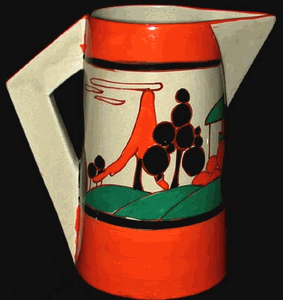
TREES & HOUSE Conical jug in the Orange Trees
& House pattern. Size 6.5 inches tall. Very nicely painted.
Spider crack to base. Signed "Fantasque by Clarice Cliff".
Price £575/$1125.
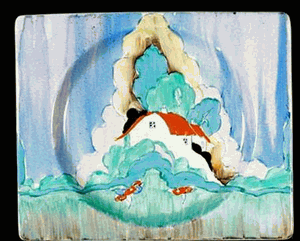
NEWLYN Biarritz shape plate by Clarice Cliff, with
a full Newlyn pattern. Size 9 by 7.5 inches. Excellent condition.
No damage or restoration. Back-stamped "Biarritz".
Date stamped 1935.Price £675/$1300.
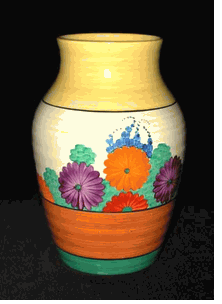
GAYDAY ISIS ISIS jug in the Gayday pattern. Excellent
condition. No damage or restoration. Size 9 inches tall. Signed
"Bizarre by Clarice Cliff". Price £595/$1155.
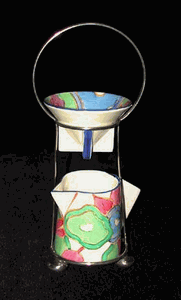
BLUE CHINTZ Rare Conical Milk and Sugar Bowl with
Metal Stand in the Blue Chintz pattern.
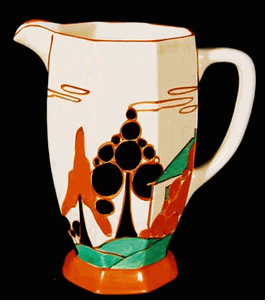
Trees and House Athens jug in Orange Trees and House
pattern. Size 7 inches tall. Very nicely painted. Signed "Fantasque
Bizarre by Clarice Cliff". Also has impressed size #
36. Very slight nick to bottom rim has now been invisibly
fixed.
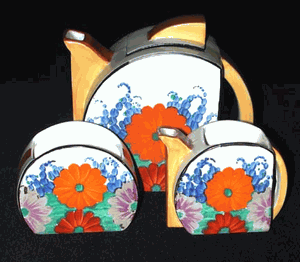
GAYDAY Teapot, Milk and Sugar in the Gayday pattern
and Stamford shape. Good condition, no damage or restoration.
The Milk jug features the rare "upturned" spout.
Slight fading of purple flowers. Each piece signed "Bizarre
by Clarice Cliff" and also marked "Gayday"
Price £1295/$2525.
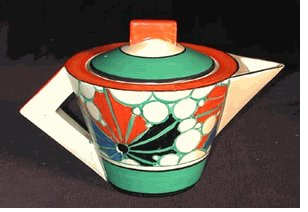
BROTH CONICAL Teapot by Clarice Cliff in the Conical
shape and Broth pattern. Large size Teapot. Six inches high.
Size Number 24. Nicely painted. A slight nick to the spout
and lid rim invisibly repaired. Signed "Fantasque by
Clarice Cliff". Price £895/$1740.
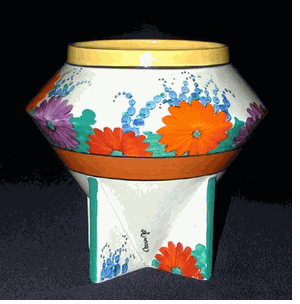
GAYDAY Great shape Vase in the Gayday pattern. Shape
number 400. Size 6 inches high. Signed "Clarice Cliff"
on the side. Excellent condition. Wonderful paintwork. Only
a slight glaze mark on the inside. Price £725/$1415.
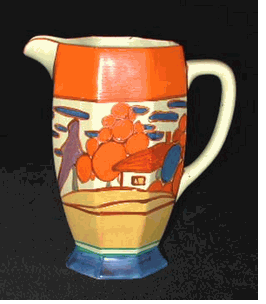
Trees and House Athens shape jug/Pitcher in the pastel
Trees and House pattern. Size 7 inches high. Signed "Fantasque
By Clarice Cliff".
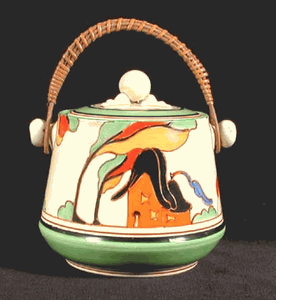
Orange House Biscuit Barrel in the Orange House pattern.
Size 6.5 inches high. Paintwork excellent. The white mark
in the picture is "flash glare", has had some minor
restoration to the rim. Signed "Bizarre Fantasque by
Clarice Cliff". Price £765/$1475.
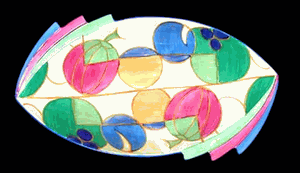
MELONS A Superb Daffodil Bowl (shape 475) in the Pastel
Melons pattern. Size 12.5 inches long. Paintwork is great
with no fading or loss. A very fresh looking piece. Slight
invisible repair to fins. Signed "Bizarre by Clarice
Cliff". Price £585/$1135.
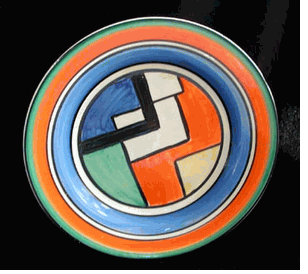
MONDRIAN Plate by Clarice Cliff in the very, very
rare Mondrian pattern. Good condition. Paintwork is excellent.
No restoration. Has a scratch to the banding on the outside
of the rim. Size 7 inches wide. From about 1929. Signed "Bizarre
by Clarice Cliff". Price £425/$825.
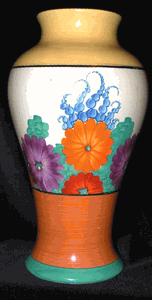
GAYDAY Large Meiping Vase in the Gayday pattern. Excellent
condition. Size 9 inches tall. Signed "Bizarre by Clarice
Cliff". Price £665/$1295.
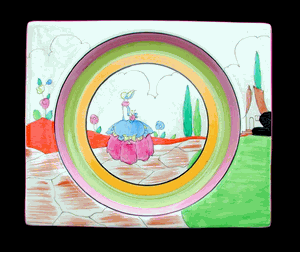
IDYLL A superb plate by Clarice Cliff in the Idyll
pattern and Biarritz shape. Excellent condition. No damage
or restoration. Size 7 by 6 inches. Signed "Bizarre by
Clarice Cliff". From about 1934. Price £625/$1215.
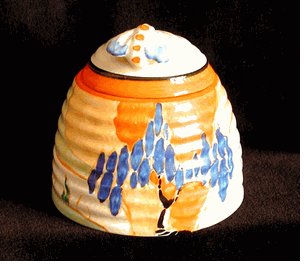
WINDBELLS HONEYPOT Large size Honeypot in the Windbells
pattern, Size 4 inches high. Paintwork is excellent. No restoration.
Lid has a slight nick near the spoon hole. This can be professionally
restored free of charge (at you choice). Signed "Bizarre
by Clarice Cliff" and "Fantasque". Price £695/$1345.
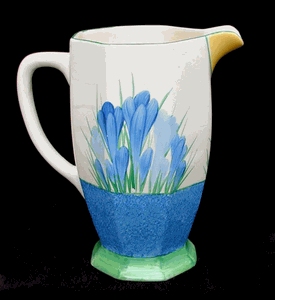
BLUE CROCUS Athens shape jug in the Blue Crocus pattern,
Size 6 inches high #42. Excellent paintwork. Has had some
nibbles on the base professionally repaired (now invisible).
Signed " Bizarre by Clarice Cliff". Price £495/$965.
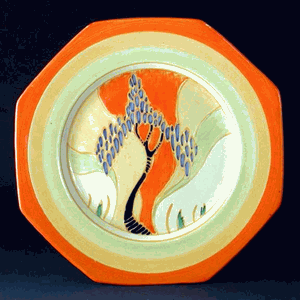
Windbells Octagonal plate in the Windbells pattern.
Size 21cm wide. Very good condition. Signed "Fantasque
Bizarre by Clarice Cliff". Price £675/$1315.
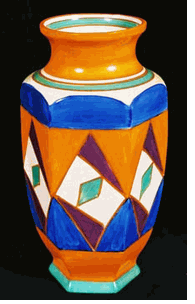
ORIGINAL BIZARRE A large Hexagonal vase by Clarice
Cliff in an Original Bizarre pattern. Shape No 37. Size 11.5
inches tall. Has had a repair to a hairline (now invisible)and
repainting to the purple. Signed in large Script "Bizarre
by Clarice Cliff". An early piece from about 1928. Price
£975/$1900.
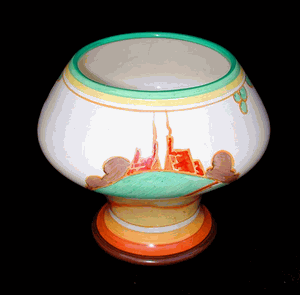
SECRETS A shape 341 Vase in the Secrets pattern. Size
6 inches high. Paintwork excellent. Has had a minor hairline
on the rim repaired (now invisible). Signed "Fantasque"
and "Bizarre by Clarice Cliff". Price £625/$1200.
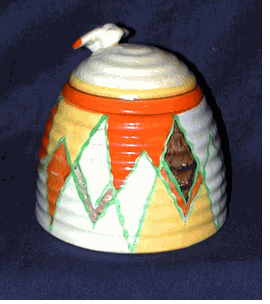
SUNGOLD HONEYPOT Large size Honeypot in the Sungold
pattern. Size 3.75 inches high. Very good condition with a
slight nick on the lid that has been invisibly repaired. Signed
"Bizarre by Clarice Cliff". Price £525/$1025.
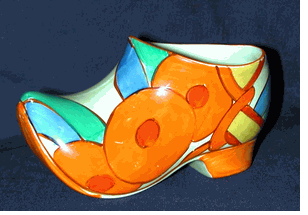
BOBBINS SABOT Sabot/Clog in the Bobbins pattern. Excellent
condition. Size 5.5 inches long. Signed "Fantasque Bizarre
by Clarice Cliff". Price £545/$1055.
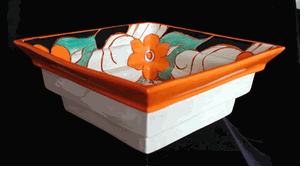
FLOREAT Square stepped bowl in the Floreat pattern.
The bowl has four steps (the bottom one is painted black).
Shape 367. No chips or hairlines. Slight repainting to the
green leaves on the inside. Size 9 inches wide and almost
5 inches high. Signed "Bizarre by Clarice Cliff".
Price £545/$1050.
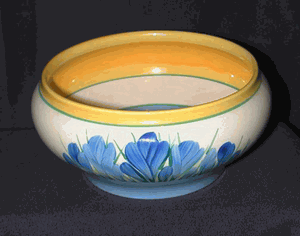
BLUE CROCUS A Bowl by Clarice Cliff in the rare Blue
Crocus pattern and the Ivor shape. 5.5 inches wide. 2.5 inches
high. Excellent condition. The Blue flowers are very well
painted with no loss and are very vibrant. The inside has
a yellow banding to the rim and the well is painted Blue.
The inside is in very good condition and has not been affected
by "Fruit acid" erosion like so many examples. To
be hyper critical there are a few scratches to the inside
and a little loss to the Blue. Signed Clarice Cliff. Item#C150.
Price £565/$1100.
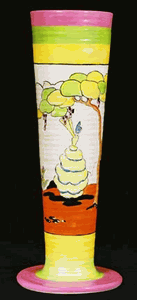
IDYLL A tall vase in the Applique Idyll pattern. Size
12.5 inches tall. Signed "Applique" and "Bizarre
by Clarice Cliff". Has had a professional repair to the
rim and base. Price £950/$1845.
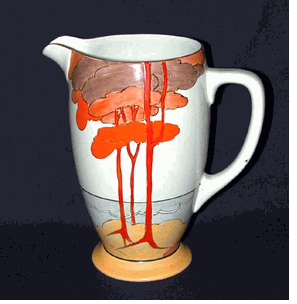
CORAL FIRS Jug/Pitcher by Clarice Cliff in the Coral
Firs pattern and Coronet shape. Size 6.5 inches high. Excellent
condition. No damage, restoration or paint loss. Signed "Bizarre
by Clarice Cliff". Price £575/$1115.
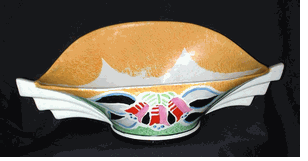
NUAGE DAFFODIL A Clarice Cliff Daffodil shape bowl
in the Nuage pattern. Shape Number 450 variation. Good condition.
Small chip to the back of the base. Size 13inches wide. From
about 1932. Very rare in that the front of the bowl is lower
than usual. Signed "Bizarre by Clarice Cliff". See
page 156 of The Rich Designs Of Clarice Cliff". Price
£675/$1315.
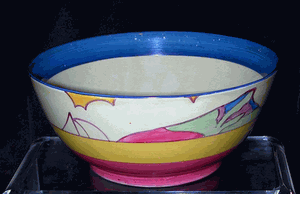
GIBRALTAR A Bowl by Clarice Cliff in the Gibraltar
pattern. Size 7 inches wide. Excellent condition with no damage
or restoration. Only a few very minor paint flecks to the
inside banding. The outside pattern is in terrific condition.
Signed "Fantasque" and "Bizarre by Clarice
Cliff". Price £545/$1050
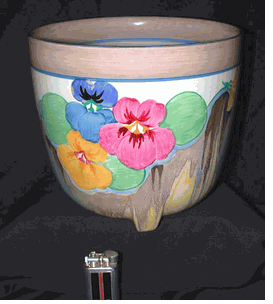
DELECIA PANSIES A large Jardiniere by Clarice Cliff
in the Delecia pansies pattern. Size 7 inches high by 7.5
inches wide. Excellent condition with great paintwork. Only
a couple of minute losses to the blue. No damage or restoration.
Not marked. The lighter at the bottom is to help show its
size. Item #C154. Price £550/$1065.
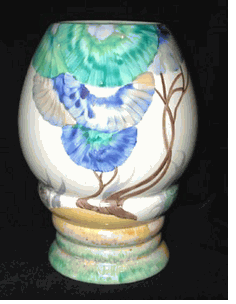
VISCARIA VASE A large shape 362 Vase by Clarice Cliff
in the Viscaria pattern. Very good condition with no chips
or hairlines. 8 inches high. Signed "Bizarre" by
" Clarice Cliff". Item #C67. Price £550/$1065.
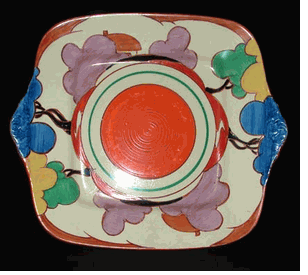
Blue Autumn A large Sandwich plate by Clarice Cliff
in the Blue Autumn pattern. Made about 1934. A rare radially
painted plate in excellent condition. No chips, hairlines
or restoration. Minor paint loss to the orange. The pattern
includes two Cottages and four Trees. 11 inches wide. Back-stamp
signed "Bizarre by Clarice Cliff" and "Fantasque".
Price £535/$1035.
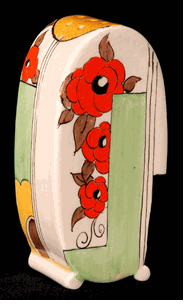
NEWPORT Sugar Sifter in the bonjour shape and Newport
pattern. No damage or restoration. Size is 5 inches high.
Signed Bizarre by Clarice Cliff and marked with an "S".
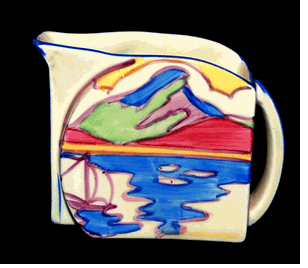
GIBRALTAR Milk jug in the Gibraltar pattern and Stamford
shape. Size is 2.5 inches high. The size is for an Early Morning
Set, Batchelor Set or Tea for Two. No damage or restoration.
Slight loss of glaze to one side of spout. Signed Fantasque
Bizarre by Clarice Cliff.
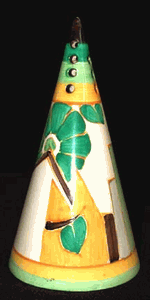
MOONFLOWER Conical Sugar Sifter in the Moonflower
pattern. Size 5.5 inches tall. No damage or restoration. Signed
"Fantasque Bizarre by Clarice Cliff". Price £875/$1700.
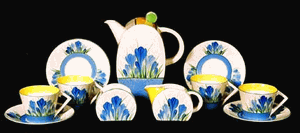
BLUE CROCUS Coffee Set for four in the Blue Crocus
pattern and Bonjour shape. Comprising Coffee pot, Milk jug,
sugar bowl and four cups and saucers. All pieces superbly
painted. The only flaw is a factory grind on the underneath
of the Coffee pot spout, which I am having re-glazed. All
pieces signed Clarice Cliff. Price £2650/$5175. SOLD
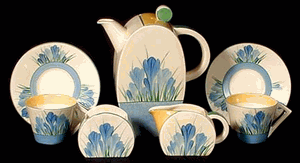
BLUE CROCUS The same set as above, but with two cups
and saucers. Price £2150/$4195. SOLD
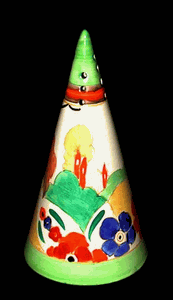
ALTON CONICAL SIFTER Conical Sugar Sifter in the Alton
pattern. Size 14cm high. Excellent condition. No damage or
restoration. Signed "Fantasque Bizarre by Clarice Cliff".
Price SOLD.
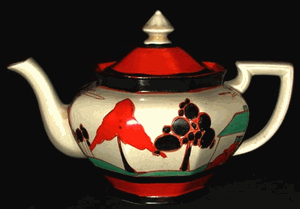
RED TREES & HOUSE Teapot by Clarice Cliff in the
Athens shape and Red Trees & House pattern. Size 9 inches
from handle to spout and 5.25 inches high. Excellent condition.
Nicely painted. Signed "Fantasque by Clarice Cliff".
Price £645/$1195. SOLD.
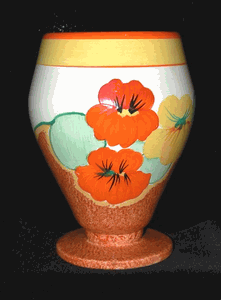
NASTURTIUM A superb Vase in the 363 shape and Nasturtium
pattern. Size 6.5 inches tall. Excellent condition. No damage
or restoration. There is a slight area to the bottom where
it appears that the paintress has missed some of the stippling.
Price £650/$1200. SOLD.
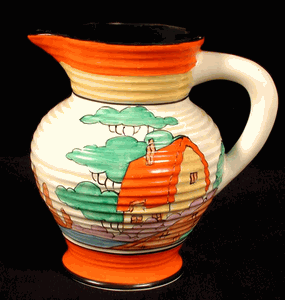
ORANGE ROOF COTTAGE Jug/Pitcher in the George shape
(shape number 564) and Orange Roof Cottage pattern. Size is
6.5 inches tall. Excellent condition. No damage or restoration.
Being very picky, minor paint fleck to rim at the back. Back-stamp
is Fantasque Bizarre by Clarice Cliff. Also marked "George
564". Price £545/$1060.SOLD.
ART
DECO FURNITURE
Coming
soon...
ART
DECO LIGHTING
Coming
soon...
ART
DECO CLOCKS
Coming
soon...
ART
DECO GLASS
Coming
soon...
ART
DECO JEWELLERY
Coming
soon...
ART DECO BIOGRAPHIES, ESSAYS AND NOTES
ALVAR AALTO
Hugo Alvar Henrik Aalto (February 3, 1898
- May 11, 1976) was a Finnish architect and designer. He was
generally known as Alvar Aalto.
He was noted for his humanistic approach and for being one
of the first and the most influential architects of Scandinavian
modernism, so much so that he is sometimes known as the "Father
of Modernism" in Scandinavia. His work includes architecture,
furniture and glassware.
He was a member of the Congres Internationaux d'Architecture
Moderne. Major works include the Finlandia Hall in Helsinki,
Finland, and the campus of Helsinki University of Technology.
Aalto's glassware includes the world-famous Aalto Vase.
He is the eponym of the Alvar Aalto Medal, now considered
one of world architecture's most prestigious awards.
Biography
Alvar Aalto was born in Kuortane, Finland. He studied architecture
at the Helsinki University of Technology from 1916 to 1921.
He returned to Jyväskylä, where he opened his first
architectural office in 1923. The following year he married
architect Aino Marsio. Their honeymoon journey to Italy sealed
an intellectual bond with the culture of the Mediterranean
region that was to remain important to Aalto for the rest
of his life.
After Aino's death Aalto married Elissa Mäkiniemi.
Works
Aalto's wide field of activity ranged from furniture and glassware
designs to architecture and painting. His vase designs are
world-famous. He invented a new form of laminated bent-plywood
furniture in 1932. Aalto furniture is manufactured by Artek,
a company Aalto co-founded. Aalto glassware (Aino as well
as Alvar) is manufactured by iittala.
PERFUME BOTTLES
Perfume bottles are essential for safe storage because perfume
is volatile and needs containers with very tight fitting lids
or stoppers to prevent evaporation. The best ones are also
made from coloured or faceted glass or other opaque material
to prevent damage to perfume from sunlight.
Perfume was important to early civilisations and some of the
earliest perfume bottles have been found in ancient Egyptian
tombs dating back to around 1500 BC.
In Venice, glassmakers were producing small highly decorated
glass bottles during the Renaissance, although few survive.
By the 16th and 17th centuries manufacture had extended to
England, France, Bohemia and Silesia. Production continued
in Italy - for example, the famous Murano glassmakers produced
bottles in coloured glass decorated with millefiori and latticino
(strands of contrasting coloured glass used as a trellis work
effect) while in Germany they were using white glass, decorated
with gilding and enamels.
By the 18th and 19th centuries, perfume containers of great
value and beauty were being made in England, using a wide
variety of materials including enamel, porcelain and silver.
They were often given as love tokens, usually by a man to
his betrothed or wife.
Enamel perfume bottles were popular during the 18th and 19th
centuries. They were made by the Battersea, Bilston and Wednesbury
factories, amongst others. The enamel bottles contained glass
phials, with stoppers, to hold the perfume and were decorated
with delicately painted flowers, landscapes and classical
scenes. Bilston was the biggest and most famous of the factories
and Dovey Hawksford probably its best known artist.
Porcelain was another widely used material and many of the
famous factories, like Chelsea, Derby and Wedgwood, produced
perfume bottles in many shapes and styles including novelty
items made to look like nuts, golf balls and shells.
As traditional Victorian style gave way to Art Nouveau and
Art Deco, perfume bottles reflected the change. Art Deco bottles
were geometric in form, many with elaborate stoppers so moving
away from the earlier more feminine and delicate designs.
René Lalique is the best-known of the Art Deco glass
designers and, of course, his perfume bottles are very collectible
but other makers are also popular. The French glassmaking
company Baccarat (company) produced perfume bottles for parfumiers
like Jean Patou, Elizabeth Arden, Guerlain and Lenthéric.
Of the other French designers of the period, Marius-Ernest
Sabino is amongst the best-known. Much of his work was an
imitation of the great Lalique but of inferior quality. However,
some of his work stands the test of time and is collectable.
The poorer work tends to be ill-proportioned and clumsy. Other
notable designers of the period include Maurice Marinot, André
Thuret and Gabriel Argy Rousseau. Czech glass-making factories
also made perfume bottles which have become collectable.
THE BAUHAUS
Bauhaus is the common term for the Staatliches Bauhaus, an
art and architecture school in Germany that operated from
1919 to 1933 and briefly in the United States from 1937-1938
and for the approach to design that it developed and taught.
The most natural meaning for its name (related to the German
verb for "build") is Architecture House. Bauhaus
style became one of the most influential currents in Modernist
architecture.
The Bauhaus art school existed in four different cities (Weimar
from 1919 to 1925, Dessau from 1925 to 1932, Berlin from 1932
to 1933) and Chicago from 1937-1938, under four different
architect-directors (Walter Gropius from 1919 to 1928, Hannes
Meyer from 1928 to 1930, Ludwig Mies van der Rohe from 1930
to 1933 and László Moholy-Nagy from 1937-1938).
These changes of venue and leadership meant a constant shifting
of focus, technique, instructors, and politics. When the school
moved from Weimar to Dessau, for instance, although it had
been an important revenue source, the pottery shop was discontinued.
When Mies took over the school in 1930, he transformed it
into a private school, and would not allow any supporters
of Hannes Meyer to attend it.
Context
The foundation of the Bauhaus occurred at a time of crisis
and turmoil in Europe as a whole and particularly in Germany.
Its establishment resulted from a confluence of a diverse
set of political, social, educational and artistic shifts
in the first two decades of the twentieth century.
Politics
The conservative modernisation of The German Empire had maintained
power in the hands of the aristocracy and necessitated militarism
and imperialism to maintain stability and economic growth.
The rise of the left in 1912 galvanised political positions
with its ideas of international solidarity and socialism set
against imperialist nationalism. World War I ensued in 1914.
In 1917 in the midst of the carnage of the First World War,
the Russian workers' and soldiers' Soviets seized power in
Russia. Inspired by the Russian workers' and soldiers' Soviets
similar German communist factions, most notably The Spartacist
League, were formed who sought a similar revolution for Germany.
The following year, the death throes of the war provoked the
German Revolution, with the SPD securing the abdication of
the Kaiser and the formation of a revolutionary government.
On January 1, 1919, the Spartacist League attempted to take
control of Berlin, this action was brutally suppressed by
the combined forces of the SPD, the remnants of the German
Army, and right-wing paramilitary groups.
Elections were held on the January 19th and the Weimar republic
was established. Communist revolution was still a tangible
prospect for many and a Soviet republic was declared in Munich,
before it's suppression by the right wing Freikorps and regular
army. Sporadic fighting continued to flare up around the country.
Art and Architecture
Art nouveau (or Jugendstil in Germany) had broken the preoccupation
with revivalist historical styles that had characterised the
19th century. In the first decade of the new century however,
the movement was receiving criticism; impelled partly by moral
yearnings for a sterner and more unadorned style and in part
by rationalist ideas requiring practical justification for
formal effects. Nonetheless, the movement had opened up a
language of abstraction which was to have a profound importance
during the 20th century. Adolf Loos was the most effective
critic, publishing Ornament and Crime in 1908 which argued
that the urge to decorate surfaces was primitive. His work
was feted by the later modern movement and acted as a catalyst
for the abandonment of surface decoration.
Two further influences upon the emergent architectural thinking
of the time can be traced from the 1903 directorships of Hans
Poelzig to the the Applied Art School in Breslau and Peter
Behrens to the Applied Art School in Dusseldorf.
The work of Peter Behrens for the German electrical company
AEG. His work attempted to bridge the widening gap between
art and mass production. He created clean-lined designs for
the company's graphics, industrial design and factories which
did not rely on surface decoration, but made full use of newly
developed materials such as poured concrete and exposed steel.
This work was much admired by the Deutscher Werkbund which
had been established in 1907 to bring German manufacturers
and artists together.
A number of artists began to develop their own creative languages
which relied increasingly on abstraction: the fauvists (c1905)
such as Georges Braque and Henri Matisse in France, Cubism
developed by Pablo Picasso and Georges Braque (c1908); der
Blaue Reiter (The Blue Rider) movement (1911) of Wassily Kandinsky,
Paul Klee, Franz Marc and August Macke in Germany; and the
Dutch de Stijl (1917) movement that included Piet Mondrian
and Theo van Doesburg.
" 1903 Hans Poelzig - directorship of applied art school
in Beslau.
" 1903 Peter Behrens - directorship of applied art school
in Dussledorf.
" 1906 Wilhelm Ernst founds the Grand-Ducal Saxon School
of Arts and Crafts in Weimar (German:Grossherzogliche Sächsische
Kunstgewerbeschule) under Henry van de Velde and the Grand-Ducal
Saxon Academy of fine arts (German:Grossherzogliche Sächsische
Hochschule für Bildende Kunst).
Expressionism
" 1914-1918 Discussions between Saxon state ministry
and Fritz Mackensen head of the Grand-Ducal Saxon Academy
of fine arts as to the relative importance in the teaching
of fine and applied art.
" 1918 Arbeitsrat für Kunst and Bruno Taut and Expressionist
architecture
" 1919 Gropius writes the pamphlet for 'Exhibition of
unknown architects' -
to go into buildings, endow them with fairy tales....and build
in fantasy[sic] without regard for technical difficulty.(frampton
p123)
" Gropius argued for autonomy of applied arts, with a
workshop-based education for both designers and craftsmen.
" Mackenson argues for artist-craftsmen to be educated
in a fine art academy.
" 1919 Gropius becomes head of composite institution
consisting of the Academy of Art and the School of Arts and
Crafts.
Society
The Bauhaus aimed to teach the arts and crafts in tandem and
to bridge the widening gulf between the art and industry.
" 1907 Deutscher Werkbund
Behrens work for AEG forged new links between art and industry.
AEG work admired by the deutsche werkbund - a crucial organization
for the coming to terms with the age of mechanisation. Improvement
of mass housing aim of werkbund.
History of the Bauhaus
Weimar
The school was founded by Gropius at the conservative city
of Weimar in 1919, as a merger of the Weimar School of Arts
and Crafts (Grossherzogliche Kunstgewerbeschule) and the Weimar
Academy of Fine Arts (Grossherzogliche Hochschule für
Bildende Kunst). His opening manifesto proclaimed:-
to create a new guild of craftsmen, without the class distinctions
which raise an arrogant barrier between craftsmen and artist.(frampton
p123)
Most of the contents of the workshops had been sold off during
World War I. The early intention was for the Bauhaus to be
a combined architecture school, crafts school, and academy
of the arts. Much internal and external conflict followed.
Gropius argued that a new period of history had begun with
the end of the war. He wanted to create a new architectural
style to reflect this new era. His style in architecture and
consumer goods was to be functional, cheap, and consistent
with mass production. To these ends, Gropius wanted to reunite
art and craft to arrive at high-end functional products with
artistic pretensions. The Bauhaus issued a magazine called
"Bauhaus" and a series of books called "Bauhausbücher".
Its head of printing and design was Herbert Bayer.
Many believe that German reform in art education was critical
for economic reasons. Since the country lacked the quantity
of raw materials that the United States and Great Britain
had, they had to rely on the proficiency of its skilled labor
force and ability to export innovative and high quality goods.
Therefore designers were needed and so was a new type of art
education. The school's philosophy basically stated that the
artist should be trained to work with the industry.
Funding for the Bauhaus was initially provided by the Thuringian
state parliament. Parliamentary support for the school eminated
from the Social Democratic party. In February 1924, the Social
Democrats lost control of the state parliament to the nationalists,
who were hostile to the Bauhaus's leftist programme. September
saw the Ministry of Education place the staff on six-month
contracts and cut the school's funding in half. For Gropius,
who had already been looking for alternative sources of funding,
this proved to be the last straw. Together with the Council
of Masters he announced the closure of the Bauhaus from the
end of March 1925. The SPD, who had governed in Dessau for
years, offered to establish the Bauhaus in the city. Gropius
and his staff moved there in 1926.
After the Bauhaus moved to Dessau, a school of industrial
design with teachers and staff less antagonistic to the conservative
political regime remained in Weimar. This school was eventually
known as the Technical University of Architecture and Civil
Engineering and in 1996 changed its name to Bauhaus University
Weimar.
Dessau
In 1927, the Bauhaus style and its most famous architects
heavily influenced the exhibition "Die Wohnung"
("The Dwelling") organized by the Deutscher Werkbund
in Stuttgart. A major component of that exhibition was the
Weissenhof Siedlung, a settlement or housing project. Gropius
was succeeded by Hannes Meyer, and then in turn by Ludwig
Mies van der Rohe.
Berlin
Paul Schultze-Naumburg
Under increasing political pressure the Bauhaus was closed
on the orders of the Nazi regime on April 11 1933. The Nazi
Party and other fascist political groups had opposed the Bauhaus
throughout the 1920s. They considered it a front for communists,
especially because many Russian artists were involved with
it. Consequently, many Weissenhof architects fled to the Soviet
Union, thus strengthening the effect. Nazi writers such as
Wilhelm Frick and Alfred Rosenberg called the Bauhaus "un-German,"
and criticized its modernist styles. (See Degenerate art.)
USA
In 1937 László Moholy-Nagy was invited by the
American Association of Arts and Industries to become the
director of the New Bauhaus in Chicago. The new school used
and developed the Bauhaus curriculum and employed some of
the staff from the German schools, many of whom had left Germany
due to the increasingly hostile political climate towards
progressive art. The focus on natural and human sciences was
intensified, and photography grew to play a more prominent
role. Too experimental for American tastes the school floundered
and closed in 1938 due to financial problems. Seven months
later the school was reopened as the School of Design (renamed
as the Institute of Design in 1944). Moholy-Nagy was succeeded
as director by Serge Chermayeff in 1946.
Architectural output
The paradox of the early Bauhaus was that, although its manifesto
proclaimed that the ultimate aim of all creative activity
was building, the school wouldn't offer classes in architecture
until 1927. The single most profitable tangible product of
the Bauhaus was its wallpaper.
During the years under Gropius (1919-1927), he and his partner
Adolf Meyer observed no real distinction between the output
of his architectural office and the school. So the built output
of Bauhaus architecture in these years is the output of Gropius:
the Sommerfeld house in Berlin, the Otte house in Berlin,
the Auerbach house in Jena, and the competition design for
the Chicago Tribune Tower, which brought the school much attention.
The definitive 1926 Bauhaus building in Dessau is also attributed
to Gropius. Student work amounted mainly to unbuilt projects,
interior finishes, and craft work like cabinets, chairs and
pottery.
In the two years under the outspoken Swiss Communist architect
Hannes Meyer, the architectural focus shifted away from aesthetics
and towards functionality. But there were major commissions:
one by the city of Dessau for five tightly designed "Laubenganghäuser"
(apartment buildings with balcony access), which are still
in use today, and another for the headquarters of the Federal
School of the German Trade Unions (ADGB) in Bernau bei Berlin.
Meyer's approach was to research users' needs and scientifically
develop the design solution.
And then Mies van der Rohe repudiated Meyer's politics, his
supporters, and his architectural approach. As opposed to
Gropius' "study of essentials", and Meyer's research
into user requirements, Mies advocated a "spatial implementation
of intellectual decisions", which effectively meant an
adoption of his own aesthetics. Neither Mies nor his Bauhaus
students saw any projects built during the 1930s.
The popular conception of the Bauhaus as the source of extensive
Weimar-era working housing is not accurate. Two projects,
the apartment building project in Dessau and the Törten
row housing also in Dessau fall in that category, but it may
be fair to say that developing worker housing was not the
first priority of Gropius nor Mies. It was the Bauhaus contemporaries
Bruno Taut, Hans Poelzig and particularly Ernst May, as the
city architects of Berlin, Dresden and Frankfurt respectively,
who are rightfully credited with the thousands of socially
progressive housing units built in Weimar Germany. In Taut's
case, the housing may still be seen in SW Berlin, is still
occupied, and can be reached by going easily from the Metro
Stop Onkel Tom's Hutte.
Impact
The Bauhaus had a major impact on art and architecture trends
in Western Europe, the United States and Israel in the decades
following its demise, as many of the artists involved fled
or were exiled by the Nazi regime.
Gropius, Breuer, and Moholy-Nagy re-assembled in England during
the mid 1930s to live and work in the Isokon project before
the war caught up to them. In the late 1930s Mies van der
Rohe re-settled in Chicago and became one of the pre-eminent
architects in the world. Moholy-Nagy also went to Chicago
and founded the New Bauhaus school under the sponsorship of
industrialist and philanthropist Walter Paepcke. Herbert Bayer,
also sponsored by Paepcke, moved to Aspen, Colorado in support
of Paepcke's Aspen projects.
Both Gropius and Breuer went to teach at the Harvard Graduate
School of Design and worked together before their professional
split in 1941. The Harvard School was enormously influential
in the late 1940s and early 1950s, producing such students
as Philip Johnson, I.M. Pei, Lawrence Halprin and Paul Rudolph,
among many others.
One of the main objectives of the Bauhaus was to unify art,
craft, and technology. The machine was considered a positive
element, and therefore industrial and product design were
important components. Vorkurs ("initial course")
was taught; this is the modern day Basic Design course that
has become one of the key foundational courses offered in
architectural schools across the globe. There was no teaching
of history in the school because everything was supposed to
be designed and created according to first principles rather
than by following precedent.
One of the most important contributions of the Bauhaus is
in the field of furniture design. The world famous and ubiquitous
Cantilever chair by Dutch designer Mart Stam, using the tensile
properties of steel, and the Wassily Chair designed by Marcel
Breuer are two examples.
The physical plant at Dessau survived the War and was operated
as a design school with some architectural facilities by the
Communist German Democratic Republic. This included live stage
productions in the Bauhaus theater under the name of Bauhausbühne
("Bauhaus Stage"). After German reunification, a
reorganized school continued in the same building, with no
essential continuity with the Bauhaus under Gropius in the
early 1920s
In 1999 Bauhaus-Dessau College started to organize postgraduate
programs with participants from all over the world. This effort
has been supported by the Bauhaus-Dessau Foundation which
was founded in 1994 as a public institution.
American art schools have also rediscovered the Bauhaus school.
The Master Craftsman Program at Florida State University bases
its artistic philosophy on Bauhaus theory and practice.
BOUCHERON
Boucheron is a French jeweller. Since its founding by Frederic
Boucheron in 1858, the House has created exceptional pieces
in the High Jewellery, watch and jewellery ranges. Throughout
the history of the House of Boucheron, Frederic Boucheron
was often a pioneer: he was the first jeweller to open on
the Place Vendôme in 1893, he did successful experiments
with diamond graving, and was the precursor of the "nature"
style by using snakes and other symbolic animal figures of
19th century Art Nouveau.
Boucheron today is one the most renown French enterprises
in the jewellery world and is celebrated for its creativity,
its know-how and audacity. Aside jewellery, Boucheron is also
known for its perfume distribution : in 1988 the brand captured
the spirit of its craft and transformed it into a fragrance
by creating the first "parfum bijou".
In 2005, a new horizon was opened to Boucheron; the creation
of a "bijoux" line came to reinforce the commercial
expansion of the brand. The House celebrates its 150th anniversary
in 2008.
MARCEL BREUER
Marcel Lajos Breuer (May 21, 1902 Pécs, Hungary - July
1, 1981 New York City), architect and furniture designer,
was an influential modernist. One of the fathers of Modernism,
Breuer showed a great interest in modular construction and
simple forms.
Known as Lajkó, Breuer studied and taught at the Bauhaus
in the 1920s, stressing the combination of art and technology,
and eventually became the head of the carpentry shop there.
He later practiced in Berlin, designing houses and commercial
spaces, as well as a number of tubular metal furniture pieces,
replicas of which are still in production today.
Breuer may be best known for his design of the Wassily Chair,
the first tubular bent-steel chair, designed in 1925 for Wassily
Kandinsky and inspired in part by bicycle handlebars. Still
in production, the chair can be assembled and disassembled
most easily with bicycle tools.
In the 1930's, due to the rise of the Nazi party in Germany,
Breuer relocated to London. While in London, Breuer was employed
by Jack Pritchard at the Isokon company; one of the earliest
introducers of modern design to the United Kingdom. Breuer
designed his Long Chair as well as experimenting with bent
and formed plywood. Breuer eventually ended up in the United
States. He taught at Harvard's architecture school, working
with students such as Philip Johnson and Paul Rudolph who
later became well-known U.S. architects. (At one point Johnson
called Breuer "a peasant Mannerist".) At the same
time, Breuer worked with old friend and Bauhaus colleague
Walter Gropius, also at Harvard, on the design of several
houses in the Boston area.
Breuer dissolved his partnership with Gropius in May 1941
and established his own firm in New York. The Geller House
I of 1945 is the first to employ Breuer's concept of the 'binuclear'
house, with separate wings for the bedrooms and for the living
/ dining / kitchen area, separated by an entry hall, and with
the distinctive 'butterfly' roof (two opposing roof surfaces
sloping towards the middle, centrally drained) that became
part of the popular modernist style vocabulary. A demonstration
house set up in the MOMA garden in 1949 caused a new flurry
of interest in the architect's work, and an appreciation written
by Peter Blake.
The 1953 commission for UNESCO headquarters in Paris was a
turning point for Breuer: a return to Europe, a return to
larger projects after years of only residential commissions,
and the beginning of Breuer's adoption of concrete as his
primary medium. He became known as one of the leading practitioners
of Brutalism, with an increasingly curvy, sculptural, personal
idiom. Windows were often set in soft, pillowy depressions
rather than sharp, angular recesses. Many architects remarked
at his ability to make concrete appear "soft".
Breuer is sometimes incorrectly credited, or blamed, for the
former Pan Am Building (now the MetLife Building), a high-rise
in New York City considered to be unpopular. The Pan Am was
actually credited to Walter Gropius. In 1969 Breuer developed
a 30-story proposed skyscraper over Grand Central Terminal,
called "Grand Central Tower", which Ada Louise Huxtable
called 'a gargantuan tower of aggressive vulgarity', and became
a cause celebre. Breuer's reputation was damaged, but the
legal fallout improved the climate for landmark building preservation
in New York City and across the United States.
ETTORE BUGATTI
Ettore Arco Isidoro Bugatti (September 15, 1881, Milan, Italy,
died on August 21, 1947) and was an automobile designer and
manufacturer.
He came from a notably artistic family that had its roots
in Milan. He was the elder son of Teresa Lorioli and her husband
Carlo Bugatti (1856-1940), an important Art Nouveau furniture
and jewelry designer. His younger brother was a renowned animal
sculptor, Rembrandt Bugatti (1884-1916), his aunt, Luigia
Bugatti, was the wife of the painter Giovanni Segantini, and
his paternal grandfather, Giovanni Luigi Bugatti, was an architect
and sculptor.
Before founding his own automobile company, Ettore designed
a number of engines and vehicles for others. Prinetti &
Stucchi produced his 1898 Type 1. From 1902 through 1904,
Dietrich built his Type 3/4 and Type 5/6/7 under the Dietrich-Bugatti
marque. In 1907, Bugatti went to work for the Deutz Gasmotoren
Fabrik, designing the Type 8/9.
On his own time, Bugatti developed the Type 2 (in 1900 and
1901), and the 1903 Type 5. While at Deutz, Bugatti built
his Type 10 in the basement of his home. In 1913, Bugatti
designed a small car for Peugeot, the Type 19 "Bébé".
Although born in Italy, Bugatti's eponymous automobile company
was set up in Molsheim, in the Alsace region, now part of
France. Ettore Bugatti was the technical innovator behind
the company, developing a number of engines and chassis for
the numerous models produced over the next three decades.
The company was known for its advanced engineering in its
premium road cars and its success in early Grand Prix motor
racing, winning the first ever Monaco Grand Prix.
Ettore Bugatti also designed a successful motorized railcar,
the Autorail, and an airplane, but it never flew. His son,
Jean Bugatti, was killed on August 11, 1939 at the age of
30, while testing a Type 57 tank-bodied race car near the
Molsheim factory. After that, the company's fortune began
to decline. World War II ruined the factory in Molsheim, and
the company lost control of the property. During the war,
Bugatti planned a new factory at Levallois in Paris and designed
a series of new cars.
Ettore Bugatti was interred in the Bugatti family plot at
the municipal cemetery in Dorlisheim near Molsheim in the
Bas-Rhin département of the Alsace region of France.
CARTIER
Cartier was founded in Paris in 1847 by Louis-François
Cartier. In 1874 his son, Alfred Cartier took over the administration
of the company, but it was his sons, Louis, Pierre and Jacques,
who were responsible for establishing the famous world-wide
brand name of Cartier.
Louis retained responsibility for the Paris branch, moving
to the Rue de la Paix, in 1899. He was responsible for some
of the company's most celebrated design innovations, like
the legendary mystery clocks, high fashion wristwatches and
exotic orientalist Art Deco designs, including the daringly
colourful "Tutti Frutti" jewels. Jacques took charge
of the London operation and eventually moved to the current
location at New Bond Street.
Pierre Cartier established the New York Branch in 1909, moving
in 1917 to the current location of 653 Fifth Avenue, the Neo-Renaissance
mansion of banker Morton Plant. Among the Cartier team was
Charles Jacqueau, who joined Louis Cartier in 1909 for his
entire life, and Jeanne Toussaint, who was Director of Fine
Jewelry from 1933 on. After the death of Pierre in 1964, Jean-Jacques
Cartier (Jacques's son), Claude Cartier (Louis's son), and
Marionne Claudelle (Pierre's daughter), who respectively headed
the Cartier affiliates in London, New York and Paris - sold
the businesses.
In 1972 a group of investors led by Joseph Kanoui bought Cartier
Paris, whose President became Robert Hocq, the creator of
the concept of "Les Must de Cartier" in collaboration
with Alain Dominique Perrin, General Director of "Les
Must de Cartier." In 1974 and 1976 respectively, Cartier
London and Cartier New York were bought back. In 1979 the
Cartier interests were combined together, creating "Cartier
Monde" uniting and controlling Cartier Paris, London
and New York.
ADOLPHE MOURON CASSANDRE
Adolphe Mouron Cassandre (January 24, 1901 - June 19, 1968)
was an influential Ukrainian-French painter, commercial poster
artist, and typeface designer.
Born Adolphe Jean-Marie Mouron in Kharkov, Ukraine to French
parents, as a young man, Cassandre moved to Paris, France
where he studied at the École des Beaux-Arts and at
the Académie Julian. Needing to earn a living, the
popularity of posters as advertising afforded him an opportunity
to work for a Parisian printing house. Inspired by cubism
as well as surrealism, he earned a reputation with works such
as Bûcheron (Woodcutter), a poster created for a cabinetmaker
that won first prize at the 1925 Exposition Internationale
des Arts Décoratifs.
Cassandre became successful enough that with the help of partners
he was able to set up his own advertising agency called Alliance
Graphique. Serving a wide variety of clientele, during the
1930s, his creations for the Dubonnet wine company were among
the first posters designed in a manner that allowed them to
be seen by occupants in fast-moving vehicles. His posters
are memorable for their innovative graphic solutions and their
frequent denotations to such painters as Max Ernst and Pablo
Picasso. In addition, he taught graphic design at the Ecole
des Arts Décoratifs and then at the Ecole d'Art Graphique.
With typography an important part of poster design, the company
created several new typeface styles. Cassandre developed Bifur
in 1929, the sans serif Acier Noir in 1935, and in 1937 an
all-purpose font called Peignot. In 1936, his works were exhibited
at the Museum of Modern Art in New York City which led to
commissions from Harper's Bazaar to do cover designs.
With the onset of World War II, Cassandre served in the French
army until the fall of France. His business long gone, he
survived by creating stage sets and costumes for the theatre,
something he had dabbled in during the 1930s. After the war,
he continued this line of work while also returning to easel
painting. In 1963, he designed the well-known Yves Saint-Laurent
logo.
In his later years, Adolphe Mouron Cassandre suffered from
bouts of depression that led to his suicide in Paris in 1968.
In 1985, Henri Mouron told his father's life story in the
a book titled A.M. Cassandre.
COCO CHANEL
Chanel herself mentioned constantly improved versions of her
childhood. However, it seems certain that she was born as
the second illegitimate daughter to the traveling salesman
Albert Chanel and his lover Jeanne Devolle in the small city
of Saumur, France. Her parents married in 1884. She had five
siblings: two sisters, Julia (born 1882) and Antoinette (born
1887) and three brothers, Alphonse (born 1885), Lucien (born
1889) and Augustin (born 1891), who died after a few months.
On 16 February 1895, when Gabrielle was 11 years old, her
mother died; her father abandoned them a short time later.
The young Gabrielle spent 7 years in the orphanage of the
Catholic monestary of Aubazine, where she learned the trade
of a seamstress. After affairs with generous wealthy men -
a military officer and later an English industrialist - she
was able to open a shop in Paris in 1910 selling ladies' hats,
and within a year moved the business to the fashionable Rue
Cambon. Her influence on haute couture was such that she was
the only person in the field to be named on TIME Magazine's
100 most influential people of the 20th century.
In 1921 Chanel No. 5 perfume was introduced by Chanel. The
perfume was the first to be sold worldwide, and stood out
from the other flamboyant perfume bottles of the time. The
No. 5 in Chanel No. 5, is said to be Coco's lucky number.
Pierre Wertheimer became her partner in the perfume business
in 1924. Wertheimer owned 70% of the company; Coco Chanel
received 10% and her friend Bader 20%. The Wertheimers continue
to control the perfume company today.
The influential Chanel suit, launched in 1923, was an elegant
suit comprising a knee-length skirt and trim, boxy jacket,
traditionally made of woven wool with black trim and gold
buttons and worn with large costume-pearl necklaces. Coco
Chanel also popularized the little black dress, whose blank-slate
versatility allowed it to be worn for day and evening, depending
on how it was accessorized. Although unassuming black dresses
existed before Chanel, the ones she designed were considered
the haute couture standard. In 1923, she told Harper's Bazaar
that "simplicity is the keynote of all true elegance."
The nickname Coco was evidently acquired at La Rotonde, a
cafe frequented by members of a French cavalry regiment and
many of the artists who flocked to Paris' Montparnasse section
at the turn of the 20th century. It was there that Chanel,
then a cabaret singer, performed a song called "Qui qu'a
vu Coco," and the name stuck. (Other sources state that
her audiences cried "Coco" when they wanted an encore,
while further sources state that the song was called "Ko
Ko Ri Ko," French for "Cock-a-doodle-do.")
Chanel was set up in business by a paramour, Étienne
Balsan, a French textile heir, and her romantic affairs with
the artist Paul Iribe, the Duke of Westminster, Grand Duke
Dmitri of Russia, and British sportsman Boy Capel all had
a considerable influence on the stylistic evolution of her
often male-inspired fashions. Coco Chanel was very well known
for minimal accesories, but was often photographed wearing
a white Camellia.
She never married. For more than 30 years, Gabrielle Chanel
made the Hôtel Ritz in Paris her home, even during the
Nazi occupation of Paris, during which time she was criticized
for anti-semitism and homophobia, and for having an intimate
affair with Hans Gunther von Dincklage, Nazi officer who arranged
for her to stay in her favorite hotel, the Hôtel Ritz
Paris. He later turned out to be an intelligence agent. She
maintained an apartment above her Rue Cambon establishment
and also owned Villa La Pausa in the town of Roquebrune on
the French Riviera. However, she spent her latter years in
Lausanne, Switzerland and is buried there in a tomb surrounded
by five stone lions.
Chanel has been portrayed on the Broadway stage by Katharine
Hepburn in a musical by Andre Previn and Alan Jay Lerner,
and on screen by the French actress Marie-France Pisier.
The House of Chanel in Paris, under Karl Lagerfeld, remains
one of the top design houses today.
PIERRE CHAREAU
The Maison de Verre (French for House of Glass) was built
from 1928 to 1931 in Paris, France. Constructed in the early
modern style of architecture, the house's design emphasized
three primary traits: honesty of materials, variable transparency
of forms, and juxtaposition of "industrial" materials
and fixtures with a more traditional style of home décor.
The primary materials used were steel, glass, and glass block.
Some of the notable "industrial" elements included
rubberized floor tiles, bare steel beams,perforated metal
sheet,heavy industrial light fixtures and mechanical fixtures.
The design was a collaboration between Pierre Chareau (a furniture
and interiors designer), Bernard Bijvoet (a Dutch architect
working in Paris since 1927) and Louis Dalbet (craftsman metalworker).
Much of the intricate moving scenery of the house was designed
on site as the project developed. The external form is defined
by translucent glass block walls, with select areas of clear
glazing for tranparency. Internally, spatial division is variable
by the use of sliding, folding or rotating screens in glass,
sheet or perforated metal, or in combination. Other mechanical
components included an overhead trolley from the kitchen to
dining room, a retracting stair from the private sitting room
to Mme Dalsace's bedroom and complex bathroom cupboards and
fittings.
The program of the home was somewhat unusual in that it included
a ground-floor medical suite for Dr. Dalsace. This variable
circulation pattern was provided for by a rotating screen
which hid the private stairs from patients during the day,
but framed the stairs at night.
The house is notable for its splendid architecture, but it
may be more well-known for another reason. It was built on
the site of a much older building which the patron had purchased
and intended to demolish. Much to his or her chagrin, however,
the elderly tenant on the top floor of the building absolutely
refused to sell, and so the patron was obliged to completely
demolish the bottom three floors of the building and construct
the Maison de Verre underneath, all without disturbing the
original top floor!
SERGE CHERMAYEFF
Serge Ivan Chermayeff (October 8, 1900 - May 8, 1996) was
a British architect, writer, and co-founder of several architectural
societies, including the American Society of Planners and
Architects.
He was born in Grozny, Russian Empire (currently Chechen Republic),
but moved to England at a young age where he received his
education. He first started working as an interior designer
for a firm in London. By 1930, he and the German architect
Erich Mendelsohn briefly partnered to form their own architectural
firm. They created some very important works in the British
modernist movement, notably the De La Warr Pavilion and was
a member of the MARS Group. In 1940, Chermayeff emigrated
to the United States where he would continue his architectural
career and would take up teaching at several universities.
In 1946, he was recommended by Walter Gropius to become the
president of the Institute of Design in Chicago. He stepped
down in 1951 when the institute merged with the Illinois Institute
of Technology. Between 1952 and 1970 he would continue to
teach at several universities including Harvard, Yale, and
MIT. He retired in 1970. He wrote several books, including
Community and Privacy with Christopher Alexander in 1964 and
The Shape of Community with Alexander Tzonis in 1971. He died
in 1996 in Wellfleet, Massachusetts.
DEMETRE H. CHIPARUS
Demetre H. Chiparus (1886-1947) was an Art Deco era sculptor
who lived and worked in Paris. He was born in Romania and
attended school in Italy. Before World War I, he traveled
to Paris to attend the Ecole des Beaux Arts and pursue his
art. In 1914 he exhibited at the Salon. He employed the combination
of bronze and ivory, called chryselephantine, to great effect.
Most of his renowned works were made between 1914 and 1933.
In the 1920's, his work was influenced by an interest in Egypt,
after Pharaoh Tutankhamen's tomb was excavated. Dancers of
the Russian Ballet, French theatre, and early motion pictures
were among his more notable subjects and were typified by
a long, slender, stylized appearance. He worked primarily
with the Etling Foundry in Paris.
CLARICE CLIFF
Clarice Cliff (January 20, 1899 - October 23, 1972), was a
ceramic artist active from 1922 to 1940.
Clarice was born in Tunstall, Stoke-on-Trent, England. She
studied at the Burslem School of Art in the evenings.
Her first job was as a gilder, and once she had mastered this
she changed jobs to learn freehand painting at another potbank,
then moved to A.J. Wilkinson's in 1916, to improve her chances
of becoming a modeller.
This was an unusual start to an unusual career, most 'pottery
girls' mastered a particular task and then stayed with that
to maximise their income as they were paid by the piece. However,
Clarice was ambitious and prepared to take wage reductions
to start at the bottom to acquire a new skill, in the process
acquiring a wide range of expertise including outlining, tube
lining, enamelling, banding and modelling.
Eventually Clarice's wide range of abilities were recognised,
and she was given an opportunity to decorate some of the factory's
defective 'glost' (white) ware in her own freehand patterns.
She covered the imperfections in simple patterns of triangles,
vividly coloured in a style that was to become known as 'Original
Bizarre'. To the surprise of the company's salesmen, this
was immediately popular. She was provided with her own studio
and another painter to assist, but this rapidly expanded to
a team of around 70 young painters, mainly women but four
boys - they hand painted the wares under her direction.
Between 1928 and 1936 she evolved a new range called Fantasque
which featured cottages and trees, and then many Art Deco
inspired paterns. These have proven particularly collectible
nowadays. Through the depths of the Depression her wares continued
to sell in volume at what were high prices for the time. Her
Bizarre and Fantasque ware was sold throughout the world,
North America, Australia, New Zealand, South Africa, but not
in mainland Europe. In Britain many top London stores sold
it, including Harrod's, but never Woolworths as some have
stated.
In 1930 she was appointed Art Director on Newport Pottery
and A. J. Wilkinson's, the two adjoining factories that produced
her wares. Her work involved spending more time with the factory
owner Colley Shorter, and this gradually developed into an
affair, conducted in secrecy. In 1940, after the death of
Ann Shorter, Colley's wife, they married and Clarice moved
into the Shorter home, Chetwynd House, where she developed
a strong interest in the extensive gardens.
During World War Two only plain white pottery was permitted
under wartime regulations, so Clarice assisted with management
of the pottery but was not able to continue design work.
After the war, most production went to the US market where
the taste was for formal ware in traditional English designs,
rather than the striking patterns and shapes that had established
Clarice's reputation. Thus she was never able to return to
creative work. A.J.Wilkinson and their Newport Pottery continued
to sell ware under Clarice's name until 1964 when the factory
was sold to Midwinter who also continued to use the 'Clarice
Cliff' brand on some pieces.
Clarice's earliest Bizarre pieces pieces from 1927 are the
traditional shapes decorated in strongly geometric patterns
of diamonds and triangles in bold contrasting colours, and
now called 'Original Bizarre'. This early ware is usually
stamped 'Bizarre' and sells for moderately high prices at
auction.
By 1929 Clarice was designing her own shapes, often very angular
and high Art Deco.
Abstract and cubist patterns appeared on these, such as Ravel,
seen on Clarice's Conical shape ware.
Clarice's are highly stylised and interpreted in strong colours,
such as the 'Honolulu' pattern.
Typically stamped 'Bizarre' or 'Fantasque', rare combinations
of shape and pattern can attract very high prices at auction.
By 1935 tastes had changed and the 'My Garden' series
Other series from this period include 'Harvest' which has
detailed modeling,
This late 1930s ware attracts relatively low prices at auction,
though becoming more valuable.
After the second world war, although Clarice had less creative
input into the ware her 'Clarice Cliff' mark was frequently
added to the standard ranges made by the factory. This postwar
ware has little value at auction.
In 1972 the first Clarice Cliff exhibition took place at Brighton,
East Sussex, for which she provided comments for the catalogue.
Later that year Clarice died suddenly at Chetwynd House. This
exhibition marked the start of a major revival of interest
in Clarice's work, which has continued to be sought after
by Art Deco Ceramic collectors. Such was the interest that
the Clarice Cliff Collectors Club was founded in 1982 [1]
which celebates it's 25th Anniversary in 2006.
A chain of mergers eventually led to Wedgwood owning the Clarice
Cliff name, and in the early 1990s they produced a range of
reproductions of the highly sought 1930s Deco pieces. These
were made to a high quality, and were produced in small numbers
for sale to collectors who could not find (or perhaps could
not afford) the most striking original pieces.
These hand painted collectors pieces ceased production in
2002 and are now acquiring significant values at auction.
Other pieces were made in larger quantities with printed (not
hand painted) patterns, and these are also starting to be
sought at auction. These reproductions should not be confused
with forgeries (of which a number are found), the Wedgwood
ones are clearly marked as 'Wedgwood Clarice Cliff' and were
produced by the current holder of the copyright.
1999 saw the centenary celebrations of Clarice's life and
work. This featured the 'Bizarre Art of Clarice Cliff' exhibition
at the Wedgwood Visitors Centre, Barlaston, Stoke-on-Trent.
This was linked to the centenary book 'Art of Bizarre' by
Leonard Griffin (Chrysalis boooks). A biography by Lynn Knight
was published in 2005.
WELLS COATES
Wells Wintemute Coates (December 17, 1895 - June 17, 1958)
was an architect, designer and writer. He was, for most of
his life, an ex-patriate Canadian architect who is best known
for his work in England. His most notable work is the Isokon
building in Hampstead, London.
Early years
The oldest of six children, Wells Coates was born in Tokyo,
Japan on December 17, 1895 to Methodist missionaries Sarah
Agnes Wintemute Coates (1864-1945) and Harper Havelock Coates
(1865-1934).
The young man's desire to be an architect was inspired by
his mother, who had herself studied architecture under Louis
Sullivan and planned one of the first missionary schools in
Japan.
Coates spent his youth in the Far East, and voyaged around
the world with his father in 1913. He served in World War
I, first as a gunner and later as a pilot with the Royal Air
Force. From 1921 to 1924, he attended the University of British
Columbia where he obtained BA and BSc degrees, and in 1924,
he moved to London where he studied engineering (obtaining
a PhD). Among his first jobs in England was as a journalist
and then with the design firm of Adams and Thompson in 1924.
He established his own firm in 1928.
His childhood experiences in Japan would play an important
role in his aesthetic sensibility that he brought to his architectural
work, and this sensibility found a fitting outlet in the Modernist
Movement, then current in Europe. He attended the 1933 Congrès
International d'Architecture Moderne (CIAM), which produced
the famous Athens Charter, and was one of the founders, with
Maxwell Fry, of the Modern Architectural Research Group (MARS),
the British wing of CIAM.
Role as a Modernist
Wells embraced Le Corbusier's architectural mantra that buildings
should be 'machines for living' (machine à habiter).
The machine á habiter ideal was best-reflected in his
Isokon building (also known as Lawn Road Flats), completed
in 1934. Indeed, the architectural critic J. M. Richards suggested
that he improved on Corbusier, coming "nearer to the
machine á habiter than anything Corbusier ever designed".
The building was compared to the exterior of an ocean liner
by the novelist Agatha Christie, who lived there for a time,
so clean and striking was the design.
The apartment building was the brainchild of Jack and Molly
Pritchard, who in 1931 established a design firm featuring
Modernist architecture and furniture. With simple living spaces
strongly influenced by Coates' Japanese experience, and including
built-in Isokon furniture, Isokon was "an experiment
in collective housing designed for left-wing intellectuals".
It became a haven for Germans escaping Nazi persecution and
hosted many famous personages including Christie, Walter Gropius
and Marcel Breuer.
Isokon was ahead of its time: it won second place in Horizon
Magazine's 'Ugliest Building Competition' in 1946, and would
not be recognized as one of England's most important Modernist
buildings for another decade. The building fell into disrepair
by the 1990's but it changed ownership in 2001 and was fully
restored by 2004.
Later Achievements
He also designed the "D-handle", a simple door handle
design commonly employed, for example, in Scandinavian furniture.
In 1930 he designed a studio for the British Broadcasting
Corporation, and among his technical designs was a microphone
stand featuring an overhead counterbalanced arm that enabled
the microphone to be moved to any part of the studio while
remaining perfectly balanced. The design became a standard
piece of equipment at the BBC.
The thirties were his most prolific era. The Isokon was immediately
followed by Embassy Court, Brighton (1935) and 10 Palace Gate,
Kensington (1939). These were the only apartment buildings
he would design. He also had several private home commissions.
During World War II, he again served with the RAF, this time
working on fighter aircraft development, for which he was
later awarded an OBE.
Following World War II, he, like some other well known architects
including Gropius and Breuer (by then working in America),
contributed to the British post-War housing effort by introducing
an early scheme for modular housing he called Room Unit Production.
He also designed a remarkable boat, called the Wingsail. It
had a rigid sail design mounted on a catamaran hull. Though
he formed a company to market the design, it was not a success,
as both the sail and the catamaran were ahead of their time.
He is less well known for his planning work. In 1937, he undertook
planning for a slum clearance in Britain (not implemented).
In Canada (1952-54) he prepared plans for Iroquois New Town
on the St. Lawrence River in eastern Ontario which were also
not implemented (the design was awarded to others). He also
prepared plans for a Toronto Island Redevelopment Project
, and was a participant in the Project 58 urban redevelopment
scheme for Vancouver.
Final Years in Canada
Coates began coming back to Canada in the early 1950's, about
the time of the Iroquois project, finally settling there in
1957. In 1955 and '56, he taught at the Graduate School of
Design at Harvard with Walter Gropius but he was not happy
there. He returned to Vancouver after two years, where he
worked on Project 58. His last assignment was to design a
monorail rapid transit system for Vancouver, dubbed the Monospan
Twin-Ride System (MTRS). Once again, he was ahead of his time.
The project was abandoned, but would be rejuvenated years
later in another form known as SkyTrain.
Wells Coates died of a heart attack in Vancouver on June 17,
1958 at the age of 63.
The University of East Anglia Library in Norwich has materials
relating to his life and work. A list of the holdings is available
on the WWW [12]. Additional reference materials from the CIAM
period are held at the CIAM Belgian Section of the Getty Research
Institute.
LE CORBUSIER
Charles-Edouard Jeanneret, widely known as Le Corbusier (October
6, 1887- August 27, 1965), was a Swiss (naturalized French)
architect, famous for his contributions to what is now called
modernism, or the International Style. He was a pioneer in
theoretical studies of modern design and was dedicated to
providing better living conditions for the residents of crowded
cities. His career spanned five decades, with iconic buildings
constructed across central Europe, India, Russia, and one
structure in the United States. He was also an urban planner,
painter, sculptor, writer and furniture designer.
Early life and education, 1887-1913
Born as Charles-Edouard Jeanneret in La Chaux-de-Fonds, a
small town of Neuchâtel canton in north-western Switzerland,
just across the border from France, Le Corbusier was attracted
to the visual arts and studied under the tutelage of the teacher
at the local arts school, Charles L'Éplattenier, who
had himself studied in Budapest and Paris. He designed his
earliest houses, like the Villa Fallet, the Villa Schwob,
and the Villa Jeanneret (the latter of which was for his parents)
in La Chaux-de-Fonds. These houses recall the indigenous mountainous
vernacular architectural styles popular in the Alps.
Frequently, in his early years he would escape the somewhat
provincial atmosphere of his hometown by traveling around
Europe. In about 1907 he travelled to Paris, where he found
work in the office of Auguste Perret, the French pioneer in
reinforced concrete. Between October 1910 and March 1911 he
worked for the renowned architect Peter Behrens near Berlin,
where he met a young Ludwig Mies van der Rohe and became fluent
in German. Both of these experiences proved influential in
his later career. Later in 1911 he would journey to the Balkans
and visit Greece and Turkey, filling sketchbooks with renderings
of what he saw, including many famous sketches of the Parthenon,
whose forms he would later praise in his work Vers une architecture
(1923).
Early career: the villas, 1914-1930
Jeanneret moved to Paris permanently at the age of 29 in 1916,
shortly after he had begun to work on theoretical architectural
studies using modern techniques. Among these was his project
for the "Dom-ino" House (1914-1915). This model
proposed an open floor plan consisting of concrete slabs supported
by a minimal number of thin reinforced concrete piers around
the edges, with a stairway providing access to each level
on one side of the floor plan. The design soon became the
foundation for most of his architecture for the next ten years.
Soon he would begin his own architectural practice with his
cousin, Pierre Jeanneret (1896-1967), a partnership that would
last until 1940.
In 1918 Jeanneret met the disillusioned Cubist painter Amédée
Ozenfant, in whom he recognized a kindred spirit. Ozenfant
encouraged him to paint, and the two began a period of collaboration.
Rejecting Cubism as irrational and "romantic," the
pair jointly published their manifesto, Après le Cubisme
and established a new artistic movement: Purism. Ozenfant
and Jeanneret established the Purist journal L'Esprit Nouveau
in 1920, in whose first issue, Jeanneret adopted the moniker
"Le Corbusier" (an altered form of his maternal
grandfather's name, "Lecorbésier") as a pseudonym,
reflecting Jeanneret's belief that anyone could reinvent himself.
Some architectural historians claim that this pseudonym translates
as "the crow-like one." Between 1918 and 1922 Jeanneret
built nothing, concentrating his efforts on Purist theory
and painting.
His theoretical studies soon advanced into several different
single-family house models. Among these was the Maison "Citrohan,"
a pun on the name of the French Citroën automaker, for
the modern industrial methods and materials Le Corbusier advocated
using for the house. Here, Le Corbusier proposed a three-floor
structure, with a double-height living room, bedrooms on the
second floor, and a kitchen on the third floor. The roof would
be occupied by a sun terrace. On the exterior Le Corbusier
installed a stairway to provide second-floor access from ground
level. Here, as in other projects from this period, he also
designed the façades to include large expanses of uninterrupted
window space. The house used a rectangular plan, with exterior
walls not filled by windows left as white, stuccoed spaces.
Le Corbusier and Jeanneret left the interior aesthetic spare,
with any movable furniture made of tubular metal frames. Light
fixtures usually comprised single, bare bulbs. Interior walls
were also left white. Between 1922 and 1927 Le Corbusier and
Pierre Jeanneret designed many of these private houses for
clients around Paris. In Boulogne-sur-Seine and the 16th arrondissement
of Paris, Le Corbusier and Pierre Jeanneret designed and built
the Villa Lipschitz, Maison Cook (see William Edwards Cook),
Maison Planeix, and the Maison LaRoche/Albert Jeanneret (which
now houses the Fondation Le Corbusier).
Five points of architecture
It was, however, Le Corbusier's Villa Savoye (1929-1931) that
most succinctly summed up his five points of architecture
that he had elucidated in the journal L'Esprit Nouveau and
his book Vers une architecture, and which he had been developing
throughout the 1920s. First, Le Corbusier lifted the bulk
of the structure off the ground, supporting it by pilotis--reinforced
concrete stilts. These pilotis, in providing the structural
support for the house, allowed him to elucidate his next two
points: a free façade, meaning non-supporting walls
that could be designed as the architect wished, and an open
floor plan, meaning that the floor space was free to be configured
into rooms without concern for supporting walls. The second
floor of the Villa Savoye includes long strips of ribbon windows
that allow unencumbered views of the large surrounding yard,
and which constitute the fourth point of his system. A ramp
rising from the ground level to the third floor roof terrace
(the fifth point) allows for an architectural promenade through
the structure. The white tubular railing recalls the industrial
"ocean-liner" aesthetic that Le Corbusier much admired.
As if to put an exclamation point on Le Corbusier's homage
to modern industry, the driveway around the ground floor,
with its semicircular path, measures the exact turning radius
of a 1929 Voisin automobile.
Forays into urbanism, 1922-1929
For a number of years French officials had been unsuccessful
in dealing with the squalor of the growing Parisian slums,
and Le Corbusier sought efficient ways to house large numbers
of people in response to the urban housing crisis. He believed
that his new, modern architectural forms would provide a new
organizational solution that would raise the quality of life
of the lower classes who lived in such dirty quarters. His
Immeubles Villas (1922) was such a project that called for
large blocks of cell-like individual apartments stacked one
on top of the other, with plans that included a living room,
bedrooms, and kitchen, as well as a garden terrace.
Not merely content with designs for a few housing blocks,
soon Le Corbusier moved into studies for entire cities. In
1922, he also presented his scheme for a Contemporary City
for Three Million Inhabitants (Ville Contemporaine). The centerpiece
of this plan was the group of sixty-story cruciform skyscrapers
built on steel frames and encased in huge curtain walls of
glass. They housed both offices and the apartments of the
most wealthy inhabitants. These skyscrapers were set within
large, rectangular park-like green spaces. At the very center
was a huge transportation center, that on different levels
included depots for buses and trains, as well as highway intersections
and at the top, an airport. (He had the fanciful notion that
commercial airliners would land between the huge skyscrapers).
Le Corbusier segregated the pedestrian circulation paths from
the roadways, and glorified the use of the automobile as a
means of transportation. As one moved out from the central
skyscrapers, smaller multistory zigzag blocks set in green
space and set far back from the street housed the proletarian
workers. Le Corbusier hoped that politically-minded industrialists
in France would lead the way with their efficient Taylorist
and Fordist strategies adopted from American models to reorganize
society.
In this new industrialist spirit, Le Corbusier began a new
journal called L'Esprit Nouveau that advocated the use of
modern, industrial techniques and strategies to transform
society into a more efficient environment with a higher standard
of living on all socioeconomic levels. He forcefully argued
that this transformation was necessary to avoid the specter
of revolution that would otherwise shake society. His dictum
"Architecture or Revolution," developed in his articles
in this journal, became his rallying cry for the book Vers
une architecture ("Towards an Architecture," translated
into English under the incorrect title Towards a New Architecture),
which was comprised of selected articles from L'Esprit Nouveau
between 1920 and 1923.
The theoretical urban schemes continued to occupy Le Corbusier.
He exhibited his Plan Voisin (sponsored by another famous
automobile manufacturer) in 1925. In it, he proposed to bulldoze
huge sections of Paris north of the Seine and replace it with
his sixty-story cruciform towers from the Contemporary City,
placed in an orthogonal street grid and park-like green space.
His scheme was met with only criticism and scorn from French
politicians and industrialists, although they were favorable
to the ideas of Taylorism and Fordism underlying Le Corbusier
designs. Nonetheless, it did provoke discussion concerning
how to deal with the cramped, dirty conditions that enveloped
much of the city.
Furniture
Le Corbusier began experimenting with furniture design in
1928 after inviting the architect Charlotte Perriand to join
his studio. His cousin Pierre Jeanneret also collaborated
on many of the designs. Before the arrival of Perriand, Le
Corbusier relied on ready-made furniture to furnish his projects,
such as the simple pieces manufactured by Thonet.
In 1928 Le Corbusier and Perriand began to put the expectations
for furniture Le Corbusier outlined in his 1925 book L'Art
Décoratif d'aujourd'hui into practice. In the book
he defined three different furniture types; type-needs, type-furniture,
and human-limb objects. He defined human-limb objects as:
"Extensions of our limbs and adapted to human functions
that are. Type-needs, type-functions, therefore type-objects
and type-furniture. The human-limb object is a docile servant.
A good servant is discreet and self-effacing in order to leave
his master free. Certainly, works of art are tools, beautiful
tools. And long live the good taste manifested by choice,
subtlety, proportion and harmony".
The first results of the collaboration were three chrome-plated
tubular steel chairs designed for two of his projects, The
Maison La Roche house in Paris and a pavilion for Henry and
Barbara Church. The line of furniture was expanded for Le
Corbusier's 1929 Salon d'Automne installation Equipment for
the Home. In the year1964, while Le Corbusier was still alive,
Cassina S.p.A. of Milan acquired the exclusive worldwide rights
to manufacture his furniture designs. Today many copies exist
but Cassina is still the only manufacturer authorized by the
Fondation Le Corbusier.
Death
On August 27, 1965, against his doctor's orders, Le Corbusier
went for a swim in the Mediterranean Sea at Roquebrune-Cap-Martin,
France. His body was found by bathers and pronounced dead
at 11 am. It is assumed that he suffered a heart attack, at
the age of 78. His death rites took place at the courtyard
of the Louvre Palace September 1, 1965 under the direction
of writer and thinker Andre Malraux, who was at the time France's
Minister of Culture.
Le Corbusier's death had a strong impact on the cultural and
political world. Homages were paid world wide and even some
of Le Corbusier's worst artistic enemies, like painter Salvador
Dalí, recognized his importance and sent a floral tribute.
In the Cold War era, the President of the United States said:
"His influence was universal and his works are invested
with a permanent quality possessed by those of very few artists
in our history". The Soviets replied: "Modern architecture
has lost its greatest master". Japanese TV channels decided
to broadcast simultaneously his Museum in Tokyo, in what was
at the time a unique media homage.
Influence
Le Corbusier was at his most influential in the sphere of
urban planning, and was a founding member of the Congrès
International d'Architecture Moderne (CIAM). One of the first
to realize how the automobile would change human agglomerations,
Le Corbusier described the city of the future as consisting
of large apartment buildings isolated in a park-like setting
on pilotis. Le Corbusier's theories were adopted by the builders
of public housing in the United States. For the design of
the buildings themselves, Le Corbusier said "by law,
all buildings should be white" and criticized any effort
at ornamentation. The large spartan structures, in cities,
but not of cities, have been widely criticized for being boring
and unfriendly to pedestrians. The city plan of Brasília
was based on his ideas, as was Chandigarh in India and the
industrial city of Zlín in Czechoslovakia. Le Corbusier's
thinking also had profound effects on the philosophy of city
planning and architecture in the Soviet Union.
Le Corbusier was heavily influenced by the problems he saw
in the industrial city of the turn of the century. He thought
that industrial housing techniques led to crowding, dirtiness,
and a lack of a moral landscape. He was a leader of the modernist
movement to create better living conditions and a better society
through housing concepts. Ebenezer Howard's Garden Cities
of To-Morrow heavily influenced Le Corbusier and his contemporaries.
René Jules Lalique
René Jules Lalique was born in Ay, Marne, France on
April 6, 1860, and died May 5, 1945.
He was a glass designer, renowned for his stunning creations
of perfume bottles, vases, jewellery, chandeliers, clocks,
and, in the latter part of his life, automobile hood ornaments.
The firm he founded is still active.
At age 16, he apprenticed with the Parisian jeweler, Louis
Aucoq. Then from 1878-1880 he attended Sydenham Art College
in London, England. After returning to France, he worked for
Aucoq, Cartier, Boucheron and others.
In 1882 he became a freelance designer for several top jewelry
houses in Paris and four years later established his own jewelry
workshop. By 1890, Lalique was recognized as one of France's
foremost Art Nouveau jewelry designers; creating innovative
pieces for Samuel Bing's new Paris shop, La Maison de l'Art
Nouveau. He went on to be one of the most famous in his field,
his name synonymous with creativity and quality.
In the 1920s he also became famous for his work in the Art
Deco style. Among other things he was responsible for the
walls of lighted glass and the elegant glass columns which
filled the dining room and grand salon of the SS Normandie.
René Lalique is buried in Le Père Lachaise Cemetery,
Paris, France.
Recognised as one of the world's greatest glass makers and
jewellery designers of the art Nouveau and art Deco periods,
Rene Jules Lalique was an imaginative and creative artist
in all his work. Lalique's early life was spent in many different
types of artistic businesses, acting as apprentice and assistant.
This heavily influenced the designs he used in his later life,
including his emphasis on glass. He used the most modern and
innovative manufacturing techniques and equipment available,
allowing more than one glass piece to be made at a time while
still looking hand made, which meant his quality jewellery
was available to the general public.
Rene Jules Lalique's early life was spent learning the methods
of design and art he would use in his later life. He was born
on the 6th of April, 1860, in the town of Ay, France. At the
age of two his family moved to a suburb of Paris due to his
fathers work, but travelled to Ay for summer holidays. These
trips to Ay influenced Lalique's later naturalistic glasswork.
When he was twelve, he entered the Collège Turgot where
he started drawing and sketching. With the death of his father
two years later, Lalique began working as an apprentice to
the goldsmith Louis Aucoq in Paris, and attending evening
classes at the Ecole des Arts Décoratifs. He worked
here for two years and then moved to London to attend the
Sydenham Art College for two years. At the Sydenham art college,
his skills for graphic design were improved, and his naturalistic
approach to art was further developed. When he returned from
England, he worked as a freelance artist, designing pieces
of jewellery for French jewellers. Following this, he opened
a business in 1885, and designed and made his own jewellery
and other glass pieces for the rest of his life.
Many things influenced Lalique's work, including the natural
environment, and the art Nouveau and art Deco periods.. The
summer holidays Lalique spent at Ay, in France, and the time
he spent at the Sydenham college of Art in London, heavily
influenced Lalique's naturalistic work. As a result, many
of his jewellery pieces and vases showcase plants, flowers
and flowing lines.
DAUM FRERES
Art nouveau (French for "new art") is a style in
art, architecture and design that peaked in popularity at
the beginning of the 20th century. Other, more localized terms
for the cluster of self-consciously radical, somewhat mannered
reformist chic that formed a prelude to 20th-century modernism,
included Jugendstil in Germany, the Netherlands and Scandinavia,
named for the avant-garde periodical Jugend ('Youth'), Mloda
Polska ('Young Poland' style), or Sezessionsstil ('Secessionism')
in Vienna, where forward-looking artists and designers seceded
from the mainstream salon exhibitions, to exhibit on their
own work in more congenial surroundings.
In Russia, the movement revolved around the art magazine Mir
iskusstva ('World of Art'), which spawned the revolutionary
Ballets Russes. In Italy, Stile Liberty was named for the
London shop, Liberty & Co, which distributed modern design
emanating from the Arts and Crafts movement, a sign both of
the Art Nouveau's commercial aspect and the "imported"
character that it always retained in Italy.
In Catalonia, the movement was centred in Barcelona and was
known as modernisme, with Antoni Gaudí as the most
noteworthy practitioner. Art Nouveau was also a force in Eastern
Europe, with the influence of Alfons Mucha in Prague and Moravia
(part of the modern Czech Republic) and Latvian Romanticism
(Riga, the capital of Latvia, is home to over 800 Art Nouveau
buildings). The entrances to the Paris Metro designed by Hector
Guimard in 1899 and 1900 are famous examples of Art Nouveau.
History of Art Nouveau
Though Art Nouveau climaxed in the years 1892 to 1902, the
first stirrings of an Art Nouveau can be recognized in the
1880s, in a handful of progressive designs such as the architect-designer
Arthur Mackmurdo's often-illustrated bookcover design for
his essay on the city churches of Sir Christopher Wren, published
in 1883. Some free-flowing wrought iron from the 1880s could
also be adduced, or some flat floral textile designs, most
of which owed some impetus to vegetal-derived patterns of
High Victorian design.
The name "Art Nouveau" derived from the name of
a shop in Paris, Maison de l'Art Nouveau, at the time run
by Siegfried Bing, that showcased objects that followed this
approach to design.
A high point in the evolution of Art Nouveau was the Universal
Exposition of 1900 in Paris, in which the "modern style"
triumphed in every medium. It probably reached its apogee,
however, at the 1902 Turin Exposition in Italy, where designers
exhibited from almost every European country where Art Nouveau
flourished. Ironically, Art Nouveau made use of many technological
innovations of the late 19th century, especially the broad
use of exposed iron and large, irregularly-shaped pieces of
glass in architecture, but by the start of the First World
War the highly stylized nature of Art Nouveau design - which
itself was expensive to produce - began to be dropped in favor
of more streamlined, simply rectilinear modernism that was
cheaper and thought to be more faithful to the rough, plain
industrial aesthetic.
Character of Art Nouveau
Dynamic, undulating and flowing, curved "whiplash"
lines of syncopated rhythm characterize much of Art Nouveau.
Another feature is usage of hyperbolas and parabolas. Conventional
moldings seem to spring to life and "grow" into
plant-derived forms.
As an art movement it has affinities with the Pre-Raphaelites
and the Symbolism (arts) movement, and artists like Aubrey
Beardsley, Alfons Mucha, Edward Burne-Jones, Gustav Klimt,
and Jan Toorop could be classed in more than one of these
styles. Unlike Symbolist painting, however, Art Nouveau has
a distinctive visual look; and unlike the backwards-looking
Pre-Raphaelites, Art Nouveau artists quickly used new materials,
machined surfaces, and abstraction in the service of pure
design.
Art Nouveau in architecture and interior design eschewed the
eclectic historicism of the Victorian era. Though Art Nouveau
designers selected and "modernized" some of the
more abstract elements of Rococo style, such as flame and
shell textures, in place of the historically-derived and basically
tectonic or realistic naturalistic ornament of high Victorian
styles, Art Nouveau advocated the use of highly-stylized nature
as the source of inspiration and expanded the "natural"
repertoire to embrace seaweed, grasses, and insects. Correspondingly
organic forms, curved lines, especially floral or vegetal,
and the like, were used.
Japanese wood-block prints with their curved lines, patterned
surfaces and contrasting voids, and flatness of their picture-plane,
also inspired Art Nouveau. Some line and curve patterns became
graphic clichés that were later found in works of artists
from all parts of the world.
Art Nouveau did not negate the machine, as other movements
such as the Arts and Crafts Movement, but used it to an advantage.
For sculpture the principal materials employed were glass
and wrought iron, leading to sculpturesque quality even in
architecture.
Art Nouveau is considered a "total" style, meaning
that it encompasses a hierarchy of scales in design - architecture,
interior design, jewellery, furniture and textile design,
utensils and art objects, lighting, etc.
Art Nouveau media
2-dimensional Art Nouveau pieces were painted, drawn, and
quite popular in printed material like advertising, posters,
labels, magazines and the like.
Glass making was an area in which the style found tremendous
expression - for example, the works of Louis Comfort Tiffany
in New York and Émile Gallé and the Daum brothers
in Nancy, France.
Jewelry of the Art Nouveau period revitalised the jeweller's
art, with nature as the principal source of inspiration, complemented
by new levels of virtuosity in enamelling and the introduction
of new materials, such as opals and semi-precious stones.
The widespread interest in Japanese art and the more specialised
enthusiasm for Japanese metalworking skills, fostered new
themes and approaches to ornament.
For the previous two centuries the emphasis in fine jewelry
had been on gemstones, particularly on the diamond, and the
jeweller or goldsmith had been principally concerned with
providing settings for their advantage. With Art Nouveau,
a different type of jewelry emerged, motivated by the artist-designer
rather than the jeweller as setter of precious stones.
The jewellers of Paris and Brussels created and defined Art
Nouveau in jewelry, and in these cities it achieved the most
renown. Contemporary French critics were united in acknowledging
that jewelry was undergoing a radical transformation, and
that the French designer-jeweller René Lalique was
at its heart. Lalique glorified nature in jewelry, extending
the repertoire to include new aspects of nature - dragonflies
or grasses - inspired by his encounter with Japanese art.
The jewellers were keen to establish the new style in a noble
tradition, and for this they looked back to the Renaissance,
with its jewels of sculpted and enamelled gold, and its acceptance
of jewellers as artists rather than craftsmen. In most of
the enamelled work of the period precious stones receded.
Diamonds were usually given subsidiary roles, used alongside
less familiar materials such as moulded glass, horn and ivory.
DONALD DESKEY
Donald Deskey was a design pioneer. He worked with Raymond
Loewy, and made some of the most recognizable icons of the
day. he designed the Crest toothpaste Packaging, as well as
the Tide BullsEye. His company is still in operation both
in Cincinnati as well as Philadelphia.
Donald Deskey also did much of the interior design of Radio
City Music Hall.
EMILE GALLE
Émile Gallé (Nancy, 8 May 1846
- Nancy, September 23, 1904) was a French artist who worked
in glass, and is considered to be one of the major forces
in the French Art Nouveau movement.
Gallé was the son of a faience and furniture manufacturer
and studied philosophy, botany, and drawing in his youth.
He later learned glassmaking at Meisenthal and came to work
at his father's factory in Nancy following the Franco-Prussian
War. His early work was executed using clear glass decorated
with enamel, but he soon turned to an original style featuring
heavy, opaque glass carved or etched with plant motifs. His
career took off after his work received praise at the Paris
Exhibition of 1878.
Within a decade of another successful showing at the Paris
Exhibition of 1889, Gallé had reached international
fame and his style, with its emphasis on naturalism and floral
motifs, was at the forefront of the emerging Art Nouveau movement.
He continued to incorporate experimental techniques into his
work, such as metallic foils and air bubbles, and also revitalized
the glass industry by establishing a workshop to mass produce
his, and other artists', designs. The factory would employ
300 workers and artisans at its height, including the notable
glassmaker Eugène Rosseau, and remained in operation
until 1936.
Gallé wrote a book on art entitled Écrits pour
l'art 1884-89 ("Writings on Art 1884-89"), which
was published posthumously in 1908.
What is less well-known is Gallé's social engagement.
He was a convinced humanist, and was involved in organizing
evening schools for the working class (l'Université
populaire de Nancy). He was treasurer of the Nancy branch
of the Ligue Française pour la Défense des Droits
de l'Homme and in 1898, at great risk for his business, one
of the first to become actively involved in the defence of
Alfred Dreyfus. He also publicly condemned the Armenian genocide,
defended the Romanian Jews and as a Protestant, spoke up in
defence of the Irish Catholics against Britain, supporting
William O'Brien, one of the leaders of the Irish revolt
EILEEN GRAY
Eileen Gray (August 9, 1878 - October 31, 1976) was an Irish
lacquer artist, furniture designer, and architect now well-known
for incorporating luxurious lacquer work into the stark International
Style aesthetic.
Early life
She first studied painting at London's Slade School of Art.
She eventually left painting to study lacquer under the guidance
of lacquer craftsman, Sugawara.
In 1913, she held her first exhibition, showing some decorative
panels at the Salon des Artistes Décorateurs. She combined
lacquer and rare woods, geometric abstraction and Japanese-inspired
motifs into her work. It attracted the attention of Jacques
Doucet, an art connoisseur and collector. He commissioned
a few pieces - her only signed and dated creations.
Her work went mostly unnoticed. In London after the start
of World War I, Gray needed to rely on her family's financial
support. Near the end of the war, Gray was commissioned to
decorate an apartment on Rue de Lota in Paris. Her interior
designs generated a great deal of praise in the press. She
opened the Jean Desert Gallery in 1922.
Increased Notoriety
Shortly thereafter, persuaded by Le Corbusier and Jean Badovici
among others, she turned her interests to architecture. In
1924 Gray and Badovici began work on the house E-1027 in Roquebrune,
Cap Martin in southern France (near Monaco). L-shaped and
flat-roofed with floor-to-ceiling windows and a spiral stairway
to the guest room, E-1027 was both open and compact. Gray
designed the furniture as well as collaborated with Badovici
on its structure. Her circular glass E-1027 table and rotund
Bibendum armchair were inspired by the recent tubular steel
experiments of Marcel Breuer at the Bauhaus (who had been
inspired, in turn, by Mart Stam). The house is now in poor
repair.
In 1968, a complimentary magazine article quickly grew into
an unexpected hit, and the Bibendum chair and E-1027 table
went back into production. Following the purchase of her archive
in 2002, the National Museum of Ireland at Collins Barracks,
Dublin opened a permanent exhibition of her work. On the 8th
November 1972, The Doucet sale added to the interest which
continues to this day in the 'antiques' of the twentieth century.
Grays 'Le Destin' screen was featured in the sale and went
for a staggering figure of $36,000. Collectors entered the
chase, and Yves Saint Laurent's interest completed the mythification
of her image.
Personal life
Gray was bisexual. She mixed in the lesbian circles of the
time, to include associations with Romaine Brooks, Gabrielle
Bloch and her lover Loie Fuller, the singer Damia, and Natalie
Barney. Gray's intermittent relationship between Damia (or
Marie-Louise Damien) ended in 1938, after which they never
saw each other again, although both lived into their nineties
in the same city. Gray also, for some time had an intermittent
relationship with Jean Badovici, the Romanian architect and
writer. He had written about her design work in 1924 and encouraged
her interest in architecture. Their romantic involvement ended
in 1932
WALTER GROPIUS
Walter Adolph Georg Gropius (May 18, 1883 - July 5, 1969)
was a German architect and founder of Bauhaus.
Life
Gropius married Alma Mahler (1879-1964), the widow of Gustav
Mahler. Walter and Alma's daughter, named Manon after his
mother, was born in 1916. When Manon died of polio at age
eighteen, composer Alban Berg wrote his Violin Concerto in
memory of her (it is inscribed "to the memory of an angel").
Gropius and Alma divorced in 1920. (Alma had by that time
established a relationship with Franz Werfel, whom she later
married.) In 1923 Gropius married Ise Frank (d. 1983), and
they remained together until his death.
Gropius, like his father and great-uncle Martin Gropius before
him, was an architect. But all sources agree that Walter Gropius
could not draw, and was dependent on collaborators and partner-interpreters
all through his career. In school he hired an assistant to
complete his homework for him. In 1908 Gropius found employment
with the firm of Peter Behrens, one of the first members of
the utilitarian school. His fellow employees at this time
included Ludwig Mies van der Rohe and Dietrich Marcks. In
1910 Gropius left the firm of Behrens and together with fellow
employee Adolf Meyer established a practice in Berlin. Together
they share credit for one of the seminal modernist buildings
created during this period, the Faguswerk, Alfeld-an-der-Leine,
Germany, a shoe last factory. The glass curtain walls of this
building demonstrated both the modernist principle that form
reflect function and Gropius's concern with providing healthful
conditions for the working class. Other works of this early
period include the office and factory building for the Werkbund
Exhibition (1914) in Cologne.
Gropius's career was interrupted by the events of 1914. Called
up immediately as a reservist, Gropius served as a sergeant
major at the Western front during the war years. Ironically
the war provided an opportunity which would advance his career
during the post war period. Henry van de Velde, the master
of the Grand-Ducal Saxon School of Arts and Crafts in Weimar
was asked to step down in 1915 due to his Belgian nationality.
His recommendation of Gropius to succeed him led eventually
to Gropius's appointment as master of the school in 1919.
It was this academy which Gropius transformed into the world
famous Bauhaus, attracting a faculty which included Paul Klee,
Johannes Itten, Josef Albers, Herbet Bayer, László
Moholy-Nagy, and Wassily Kandinsky. Students were taught to
use modern and innovative materials and mass-produced fittings,
often originally intended for industrial settings, to create
original furniture and buildings.
Also in 1919, Gropius was involved in the Glass Chain utopian
expressionist correspondence under the pseudonym 'Glass'.
Usually more notable for his functionalist approach, the "Monument
to the March Dead" indicates that expressionsism has
clearly an influence on him at this time.
In 1923, Gropius designed one of his most famous works, door
handles, now considered an icon of 20th century design and
often listed as one of the most influential designs to emerge
from the Bauhaus.
Gropius fled Germany in 1934 due to the rising power of the
Nazi Party, and lived and worked in Britain, at the Isokon
project, and then, from 1937 to the United States, where his
own house, the Gropius House in Lincoln, Massachusetts, was
influential in bringing International Modernism to the US.
Gropius did not like the term: "I made it a point to
absorb into my own conception those features of the New England
architectural tradition that I found still alive and adequate"
Gropius and his Bauhaus protégé Marcel Breuer
both moved to Cambridge, Massachusetts to teach at the Harvard
Graduate School of Design and collaborate on the company-town
Aluminum City Terrace project in New Kensington, Pennsylvania,
before their professional split. In 1944, he became a naturalized
citizen of the United States.
In 1945, Gropius founded The Architects' Collaborative (TAC)
based in Cambridge with a group of younger architects. The
original partners included Norman C. Fletcher, Jean B. Fletcher,
John C. Harkness, Sarah P. Harkness, Robert S. MacMillan,
Louis A. MacMillen, and Benjamin C. Thompson. TAC would become
one of the most well-known and respected architectural firms
in the world. TAC went bankrupt in 1995.
Gropius died in 1969 in Boston, Massachusetts, aged 86. Today,
he is remembered not only by his various buildings but also
by the district of Gropiusstadt in Berlin.
JOSEF HOFFMAN
Josef Hoffmann (December 15, 1870 - May 7, 1956) was an Austrian
architect and designer of consumer goods. He studied with
Otto Wagner. He played a major part in the shaping of the
aesthetic perception and aesthetic understanding of the 20th
century.
In today's Czech Republic (including Bohemia and Moravia),
the results of the Industrial Revolution were more obvious
than in the other parts of the Austro-Hungarian Empire. Josef
Hoffmann (born in 1870 in Pirnitz, Moravia, now Brtnice, Czech
Republic) and Adolf Loos both came from that same area. Many
creative minds derived from this region and enriched Vienna's
economic life in the empire at the turn of the century.
From 1887, Hoffmann attended the technical college in Brünn,
where he studied the methods of classical architecture. After
his practical year in Würzburg as a student of architecture,
Hoffmann studied from 1892 at the Academy of Fine Arts in
Vienna built by Theophil Freiherr von Hansen. His teacher,
Karl Freiherr von Hasenauer was then at the peak of his popularity
due to his "Ringstraßenbuildings".
After Hasenauer's death, Otto Wagner, the most famous architect
at the end of the nineteenth century, took over his class.
A scholarship from the "Prix de Rome" enabled Hoffmann
to stay in Italy. After his return, Hoffmann joined the office
of Otto Wagner. There he got acquainted with Josef Maria Olbrich.
Vienna Sezession
Together with other artists, Josef Hoffmann established the
so-called "Siebener Club". After Hoffmann demonstratively
left the Künstlerhaus with a number of colleagues including
Gustav Klimt and Kolo Moser, an organisation of graphic artists,
the Secession, was founded in 1897. The new organisation's
home built by Josef Maria Olbrich offered young Hoffmann,
as an organiser of the exhibitions, ideal opportunities to
present himself to an art loving and progressive circle of
potential clients. The society of those days seemed to show
an interest in art to an extent which was unknown before.
The conventional salons, academies and the like very quickly
lost their influence in the same way - as modernity questions
the authority of tradition.
Hoffmann's works from this time were clearly influenced by
Otto Wagner's school, which determined the structure of an
object through the emphasis on the surface. This was as important
to Hoffmann as Belgian Art Nouveau influenced the Secessionists.
In 1899 Hoffmann was appointed as a professor at the Viennese
School of Applied Arts(Kunstgewerbeschule) and commissioned
for the interior-design at the World Fair in Paris in 1900.
Starting from the beginning of the 20th century a basic change
in his style can be noticed. With the turning away from the
curves of the Secession and Art Nouveau a trend towards simpler
forms appeared. At this time patterns from Britain had their
special influence on Hoffmann. His admiration of the latest
developments in architecture and applied arts in Britain is
easy to be explained. On the one hand numerous illustrated
magazines allowed an exchange of information. On the other
hand there was a number of Secession exhibitions where British
artists took part amongst them C.R. Ashbee and Charles Rennie
Mackintosh.
Starting with the 14th exhibition of the Vienna Sezession
(1902) there was a strict move to independence from other
countries with the benchmark of The "Suppraportenrelief",
a cubist engraving in plaster, designed by Josef Hoffmann
for the foyer of the Secession building.
Hoffmann's explanation for his favour for circles and squares
was that these forms never have been used before in applied
and fine arts.
Hohe Warte
During this very important phase of development Hoffmann was
appointed to build a colony of villas on the hills of the
Hohe Warte in Vienna. Due to the Secession activities, Hoffmann
was a close friend of the customers, and this gave him the
chance to design houses that suited both his and the builders'
ideal. This was to reach an unity of both, the outside and
inside, or as in Hoffmann's own words, "to build a house
who's exterior is one with the interior".
He moved away from the Secession and for the first time he
reveals his own unmistakable and independent style. Hoffmann's
turn away from the sweeping curves of Art Nouveau and his
turn towards simpler forms has to be seen in the historic
context of moving away from the floral Jugendstil, which started
to spread in Europe around 1900 and went along with the renaissance
of classical ideals. Following the Hohe Warte houses Hoffmann
was appointed to do the interior decoration of a number of
Viennese apartments. At that time he was Vienna's most fashionable
architect. His works were so revolutionary that one could
say, a new era had begun. In later years Hoffmann explained
his interest in square shapes and the often use of black and
white of those days by arguing that these clear elements never
had been incorporated in the styles of previous epochs.
The sculpture "Supraportenrelief" was created by
Hoffmann for the fourteenth exhibition of the Secession in
1902 . It is known for its final turning point towards a new
feeling for design. Workshops started all over the world to
find new and contemporary forms, which no longer wanted to
follow the example of historical tradition.
The Wiener Werkstätte
With the fortune of the young and art loving industrialist
Fritz Wärndorfer and with the enthusiasm and creative
power of Kolo Moser and Josef Hoffmann the Wiener Werkstätte
was founded in May 1903 - the productive community of artists
and craftsmen who was meant to impress the life of Hoffmann
deeply as well as that of the whole Viennese art scene.
The clear goal of the Wiener Werkstätte was to include
all prospects of human life into one unified work of art.
It was also decided to approve only objects of outstanding
individuality and beauty and high attention was put on exclusive
and exquisite craftsmanship. This followed the organisation's
motto: better to work ten days at one piece than to manufacture
ten pieces in one day.
The Wiener Werkstätte created pieces of arts, in a very
distinctive style: the Wiener Werkstätte Style.
Sanatorium Purkersdorf
Between 1902 and 1904 Hoffmann's purist phase reached its
peak and he concentrated solely on the reform of the element.
Such an amount of purism often went against the wishes and
intentions of his patrons, as they often longed for the richness
of historical furniture which was meant to match with their
lifestyle. Hoffmann's artistic fantasy would later be able
to react on such a demand. Once he had moved away from his
phase of riding himself of historic weights he was again ready
to let Art deco developments flow into his work.
The first big order for Josef Hoffmann and the Wiener Werkstätte,
the building of the Sanatorium Purkersdorf (1904) including
its interior design, came about by the acquaintance of the
building contractor with the art critic Berta Zuckerkandl.
As a supporter of the Secession and admirer of Josef Hoffmann,
she recommended him to the builder.
The Sanatorium was designed for a circle of well-off patients.
Dedicated to the highest levels of comfort and luxury, in
its construction Hoffmann made use of the most modern available
techniques - reinforced concrete. His original plan showed
that he was inclined to take even more radical advantage of
new construction techniques than in practice were actually
possible. Decoration on the building was used sparingly. The
intended purpose of the Sanatorium pulled for a level of hygienic
sobriety which helped Hoffmann in his design. After 1904 a
number of projects were carried out where Hoffmann's search
for simple forms are clearly perceivable but the choice of
material and the working methods made the objects even more
splendid and opulent.
Palais Stoclet
The internationally recognised peak of Hoffmann's career is
the Palais Stoclet in Brussels. Its dimension, quality and
architectural significance was an accomplishment that was
not to be surpassed throughout his long career. Not only had
materials and techniques of manufacturing become more complicated
but also a change into a new direction of Hoffmann's creative
work is distinguishable as of 1905, when a return to shapes
of classicism occurred.
All these tendencies were channelled into the building and
coupled with the financial strength of Baron Stoclet. This
order resulted in Europe's probably most spectacular masterpiece
of complete art of its epoch. When building the Palais Stoclet,
the relationship between the patron and his architect was
the happiest imaginable. A fact which is clearly expressed
in the consequent atmosphere and quality of the building where
no compromises were made, neither with the outside finish
nor with the interior.
The same artists, who worked on Stoclet were also involved
in the design of the Cabaret Fledermaus in Vienna. Apart from
Hoffmann many other artists like Czeschka Wimmer-Wisgrill.
In 1912 they were the founders of the Austrian artist group
"Werkbund".
Later life
Before Word War I the works of Josef Hoffmann shortly reveal
an individual approach to classicism and ideally reflect the
need of representation of a social class, whose days were
already counted due to political circumstances. The Villa
Skywa-Primavesi was Hoffmann's last great performance before
the war, whose outbreak put an end to private enterprises
for a number of years.
After 1919, Josef Hoffmann was very ill for many years. He
even had to pass on the management of his studio to Oswald
Haertl for some time. But Hoffmann applied himself to the
creation of new forms till his death.
After World War II, Hoffmann assumed a number of official
duties but received less commissions for design. His official
engagements comprised the membership of the art-senate and
the Austrian general commissioner for the Biennalein Venice.
In May 1956, Hoffmann died at the age of 85. His life's work
includes all areas of fine arts. As the initiator of the Vienna
Sezession he had a decisive influence on the drawings and
the painting of his time. As a founder of the Wiener Werkstätte
he revolutionised the arts and crafts.
ISOKON
The London-based Isokon firm was founded in 1929 to design
and construct modernist houses and flats, and subsequently
furniture and fittings for them. Originally called Wells Coates
and Partners, the name was changed in 1931 to Isokon, a name
derived from Isometric Unit Construction, bearing an allusion
to Constructivism.
Unusually for a design company, its directors were a bacteriologist
Molly Pritchard, a solicitor Frederick Graham-Maw,son of the
founder of the law firm, Rowe and Maw, Frederick James Maw
and an economist Robert S Spicer. In actuality, the company
was run by Molly's husband Jack Pritchard whose initial involvement
was to handle the economics, publicity and marketing, but
who later went on to hire designers and direct the company.
Isokon's key project was the Lawn Road Flats in Hampstead,
sometimes called the Isokon building, which opened on 9 July
1934. Intended to be the last word in contemporary modernist
living, the block of flats were aimed at the market of new
young professionals of the 1930s and contained 22 single flats,
4 double flats, 3 studio flats, staff quarters, kitchens and
a large garage. In 1937 a club, the Isobar, was added to the
complex.
The flats and paticularly the bar became famous as a centre
for intellectual life in North London, famous residents included
Agatha Christie, and regulars at the Isobar included Henry
Moore, Barbara Hepworth and Ben Nicholson.
In 1935, Walter Gropius, the former head of the Bauhaus, became
Controller of Design for Isokon. He arrived in England on
18 October 1934 and lived in one of the Lawn Road Flats until
March 1937, when he and his wife left for USA.
A month before he left for the USA, Gropius recommended Marcel
Breuer, a former colleague at the Bauhaus, as his replacement
for Controller of Design. The furniture Breuer designed whilst
at Isokon are highly influential pieces of the modernist movement,
and included chairs, tables and the Long Chair.
László Moholy-Nagy, another former Bauhaus teacher,
also became involved with Isokon when he arrived in Britain
from Germany in May 1935 and designed promotional material,
including sales leaflets, showcards and the logo of Isokon
firm itself, which was an outline of curved plywood chair.
However Isokon was never commercially successful. But the
end came when World War II began and its supply of plywood
was cut off. The Isokon Furniture Company ceased production
in 1939.
Jack Pritchard revived Isokon Furniture Company in 1963. However
changes in the manufacture of plywood meant a redesign of
some of the key pieces in the Isokon portfolio, for which
Pritchard hired Ernest Race. In 1968, Pritchard licensed John
Alan Designs to produce the Long Chair, Nesting Tables and
the Penguin Donkey 2 which the company did until 1980.
In 1982, Chris McCourt of Windmill Furniture took over the
license to manufacture Isokon pieces. Since 1999, this furniture
has been sold through the retail arm of Windmill's, Isokon
Plus in Chiswick, London.
Isokon furniture - Isokon Stool (designer unknown, 1933) -
Isokon Book Units (designed by Wells Coates, 1933) - Desk
made from Isokon Book Units (designed by Wells Coates, 1933)
- Aluminium Waste Paper Basket (designed by Walter Gropius,
1935) - Side Table GT2 (designed by Walter Gropius, 1936)
- Isokon Nesting Tables (designed by Marcel Breuer, 1936)
- Isokon Dining Table (designed by Marcel Breuer, 1936) -
Isokon Stacking Chairs (designed by Marcel Breuer, 1936) -
Isokon Long Chair (designed by Marcel Breuer, 1935-6) - The
Pocket Bottleship (designed by Egon Riss, 1939) - The Pocket
Bottleship Mark 2 (designed by Ernest Race, 1963) - The Penguin
Donkey (designer by Egon Riss, 1939) - The Penguin Donkey
Mark 2 (designed by Ernest Race, 1963)
JULES LELEU
Jules Leleu (1883-1961) was a French Art Deco Designer.
He was born in Boulogne-sur-Mer, France and at age 26 succeeded
his father in the family painting business. With his brother
he began work in the Decorating field. After World War I,
Leleu specialized in furniture making. He opened a Paris gallery
in 1924 and exhibited at the 1925 Exposition Industrielle
et Arts Decoratifs. Leleu designed the Grand Salon of the
Ambassadors at the Society of Nations in Geneva and the French
Embassies of several nations. He contributed furnishings for
numerous steamships in the 1930s.
TAMARA DE LEMPICKA
Tamara de Lempicka (May 16, 1898, Warsaw, Poland - March 18,
1980 Cuernavaca, Mexico) , noted Art Deco painter, was born
Maria Górska in a wealthy family in Warsaw, Poland
(then in the Russian Empire).
Early life
In 1912, after her parents divorced, she was sent by her grandmother
to school in Lausanne, Switzerland. In 1914 she married a
lawyer named Tadeusz Lempicki in St. Petersburg, Russia.
Russian Revolution
In 1917, during the Russian Revolution, Tadeusz was arrested
by the Bolsheviks. Although only seventeen years old, Tamara
pleaded for, and finally secured, his release.
The Lempickis then fled to Paris, France where she became
known as Tamara de Lempicka. She studied art and became a
well-known portrait painter, developing a distinctive and
bold style, sometimes referred to as soft cubism, which epitomizes
the cool modernism of Art Deco.
Social Life
Tamara de Lempicka was bisexual, and her affairs with both
men and women were carried out in ways that were scandalous
at the time. She often used formal and narrative elements
in her portraits and nude studies to produce overpowering
effects of desire and seduction.
Following World War I she became closely associated
with lesbian and bisexual women in writing and artistic circles,
such as Violet Trefusis, Vita Sackville-West, and Colette.
She also became involved with Suzy Solidor, a night club singer
at Boîte de Nuit, whom she later painted.
At the outset of the second World War she moved to Beverly
Hills, California with her second husband, Baron Raoul Kuffner,
whom she married in 1933. In 1943 they relocated to New York
City where she continued to paint in her trademark style.
After Baron Kuffner's death from a heart attack in 1962, Tamara
moved to Houston, Texas and began painting in a new style,
using a palette knife rather than a brush to lay down the
paint. Her new paintings were not well received, and Tamara
swore that she would never exhibit her work again.
She later ceased painting and in 1978 she moved to Cuernavaca,
Mexico. She died in her sleep on March 19, 1980 and her ashes
were scattered over the volcano Popocatepetl by Count Giovanni
Agusta.
EDWARD MAUFE
Sir Edward Brantwood Maufe was an English architect born 12th
December 1883 in Ilkley. He died on his birthday in 1974 in
Buxted, East Sussex. His works include Kelling Hall in Norfolk,
the Festival Theatre in Cambridge, the Air Forces Memorial
overlooking Runnymede, the Oxford Playhouse, St Columba's
Church (Pont Street, London, SW1) and Guildford Cathedral
1932.
Apparently indexed in the on-line 1901 Census as "Edward
B.Muff" an architect in Hampstead, he moved with his
parents during the next decade to Red House, Bexleyheath,
London which was originally designed for, and owned by William
Morris. When he received a knighthood early in 1954, Edward
lived at 139 Old Church Street, Chelsea, London SW3.
KOLOMAN MOSER
Koloman Moser (March 30, 1868-October 18, 1918) was an Austrian
artist who exerted an incomparable influence on twentieth-century
graphic art and one of the foremost artists of the Vienna
Secession movement. During his short life, Moser designed
an astounding array of art works - books and graphic works
from postage stamps to magazine vignettes; fashion; stained
glass windows, porcelains and ceramics, blown glass, tableware,
silver, jewelry, and furniture - to name a few of his interests
He studied at the Wiener Akademie and the Kunstgewerbeschule,
where he also taught from 1899.
His designs in architecture, furniture, jewelry, graphics,
and tapestries helped characterize the work of this era. Moser
drew upon the clean lines and repetitive motifs of classical
Greek and Roman art and architecture in reaction to the Baroque
decadence of his turn-of-the-century Viennese surroundings.
In 1903, Moser and his colleague Josef Hoffmann founded the
Wiener Werkstätte, whose workshops produced a number
of aesthetically and functionally designed household goods,
including glassware, flatware, silverware, and textiles.
In 1901/1902, he published a portfolio titled Die Quelle(The
Source) of elegant graphic designs for such things as tapestries,
fabrics, and wallpaper.
In 1904, he created the Apse mosaic and glass windows for
the Kirche am Steinhof in Vienna.
In 1905, together with the Klimt group, he separated from
the Vienna Secession.
OMEGA WORKSHOPS
The Omega Workshops were a design enterprise
by members of the Bloomsbury group and were founded in 1913.
Critic Roger Fry formed the company and works were shown anonymously,
marked only with the letter omega.
Vanessa Bell and Duncan Grant produced designs for Omega,
and Wyndham Lewis was initially part of the operation. Lewis
however split off at an early stage, taking with him several
other participants to start the Rebel Art Centre after accusing
Fry of misappropriating a commission to decorate a room at
the Ideal Home Exhibition in the autumn of 1913.
Edward Wolfe worked at the Omega Workshops handpainting candle-shades,
trays and decorating furniture. Wolfe, who died in 1982, was
one of the last of the Bloomsbury painters.
Omega closed in 1919, but became influential in interior design
in the 1920s.
A revival of interest in Omega designs in the 1980s led to
a reassessment of the place of the Bloomsbury group in visual
arts.
ORREFORS
Orrefors Glasbruk is the Swedish glassworks from the town
Orrefors. The house was founded in 1898 and originally made
window glass and practical objects such as jam jars. However
the company changed ownership in 1913, and by 1916 attempted
to take their work into a more artistic direction. Two Swedish
painters, Simon Gate and Edvard Hald, were hired to decorate
and design the glass, despite neither of them having any experience
with the medium. They were later joined by other artists like
Vicke Lindstrand and Edvin Öhrstrom. Each of these people
had their own artistic style, but together created several
unique features and innovations. One of these was Graal glass,
where colored relief decorations are encased in another layer
of colorless and transparent crystal which gives a smooth
surface. A similar technique was devised in 1936 which trapped
air within the walls of the glass. This was known as Ariel,
a name derived from Shakespeare's play The Tempest. A major
influence of theirs was the Art Nouveau work of the French
artist Émile Gallé. Their designs use characteristic
clean lines of brilliant crystal that suggests a frozen liquid.
Their work was greatly admired when it was displayed to a
wide audience at the Paris Ehibition of 1925. The glass house
came to be a leading producer during the interwar period.
In more recent times the factory has also become noted for
its chandelier-making. However some of the older designs are
still produced today.
GIO PONTI
Giò Ponti (18 November 1891, Milan- 16 September, 1979,
Milan) was an Italian architect. His parents were Enrico Ponti
and Giovanna Rigone. Gio Ponti did military service during
World War I in the Pontonier Corps with the rank of captain,
from 1916 to 1918, receiving the Bronze Medal and Miliitary
Cross.
Gio Ponti graduated with a degree in architecture in 1921
from the Milan Polytechnic, and set up a studio with the architects
Mino Fiocchi and Emilio Lancia in Milan. Later, he went into
partnership with Lancia (Studio Ponti e Lancia, PL: 1926-1933);
then with the engineers Antonio Fornaroli and Eugenio Soncini
(Studio Ponti-Fornaroli-Soncini, P.F.S.:1933-1945).
In 1921, he married Giulia Vimercati; they were to have four
children and eight grandchildren. From 1923 came his public
debut at the first Biennial Exhibition of the Decorative Arts
in Monza, which was followed by his involvement in organization
of the subsequent Triennial Exhibitions on Monza and Milan.
From 1923 to 1930 he worked at the Manifattura Ceramica Richard
Ginori, in Milan and Sesto Fiorentino, changing the company's
whole output.
In 1928 he founded the magazine Domus. From 1936 to 1961 he
was professor on the permanent staff of the Faculty of Architecture
at the Milan Polytechnic.
In 1941 he resigned as editor of the magazine Domus and set
up the magazine Stile, which he edited until 1947. In 1948
he returned to Domus, of which he remained the editor until
the end of his life.
In 1952 he went into partnership with the architect Alberto
Rosselli (Studio Ponti-Fornaroli-Rosselli, P.F.R.: 1952-1976);
after the death of Rosselli he continued to work with his
long time partner Antonio Fornaroli
GERRIT RIETVELD
Gerrit Thomas Rietveld (Utrecht June 24, 1888 - Utrecht June
26, 1964), was a Dutch designer, architect and cabinet maker.
In 1911, Rietveld started his own furniture factory, while
studying architecture. Rietveld designed the Red and Blue
Chair in 1918, influenced by the 'De Stijl' movement, of which
he became a member in 1919, the same year in which he became
an architect. In 1924 he designed the Schröder house
for Truus Schröder-Schräder, with whom he cooperated.
The house is located in Utrecht. The house, while guided by
geometric forms, is asymmetrical.
Rietveld broke with the 'De Stijl' movement in 1928 and switched
to the Nieuwe Zakelijkheid. The same year he joined the Congres
Internationaux d'Architecture Moderne.
He designed the "Zig-Zag" chair in 1934 and started
the design of the Van Gogh Museum in Amsterdam.
EMILE-JACQUES RUHLMANN
Émile-Jacques Ruhlmann (28 August 1879, Paris - 1933),
his first names often seen reversed as Jacques-Émile,
was a renowned French designer of furniture and interiors,
epitomising for many the glamour of the French Art Deco style
of the 1920s.
He was born in Paris from Alsatian parents who were in the
general decorating business. When his father died in 1907
he took over the family firm.
In 1919 Ruhlmann founded, with Pierre Laurent, the company
Ruhlmann et Laurent, specialising in interior design and producing
luxury home goods that included furniture, wallpaper and lighting.
By this time, Ruhlmann was making formal elegant furniture
using precious and exotic woods in combination with ivory
fittings, giving them a classic, timeless appeal.
Ruhlmann's legacy as a designer was the subject of a major
retrospective exhibition at the New York Metropolitan Museum
of Art in 2004.
SUSIE COOPER
Susie Cooper (October 29, 1902 - July 28, 1995) was a prolific
ceramic designer working in the Stoke-on-Trent pottery industries
from the 1920s to the 1980s.
Life and work
Born in the Stanfields area of Stoke-of-Trent, she was the
youngest of seven children. From an early age she developed
an interest in drawing, and began her art education by attending
night classes at the Burslem School of Art. In 1922, she joined
A.E. Gray & Co. Ltd, partially as a means to gain entry
to the Royal College of Art.
A. Edward Gray quickly discovered her talents as a painter
and designer, and soon enough Susie was producing her hand-painted
floral designs. In 1923, A.E.Gray launched the Gloria Lustre
Range employing the technique of lustreware. In 1929, motivated
by her desire to design ceramic shapes in addition to decors,
she broke away with her brother-in-law Albert "Jack"
Beeson to set up her own business, as Susie Cooper Potteries.
Susie worked for many other pottery firms over the next several
decades, including Wedgwood. In 1940, she was awarded the
Royal Designer for Industry by the Royal Society of Arts,
and in 1979 she received an OBE. By all accounts Elizabeth,
The Queen Mother was an admirer of her work.
At the age of 80 she retired to live on the Isle of Man, where
she died in 1995. Like other Potteries based ceramic designers
such as Clarice Cliff and Charlotte Rhead, her work has become
highly sought after and valued by pottery collectors.
LOUIS COMFORT TIFFANY
Louis Comfort Tiffany (February 18, 1848 - January 17, 1933)
was an American artist and designer who is best known for
his work in stained glass and is the American artist most
associated with the Art Nouveau movement. Tiffany was a painter
and interior decorator and designed stained glass windows
and lamps, glass mosaics, blown glass, ceramics, jewelry,
enamels and metalwork.
Personal life
Louis was the son of Charles Lewis Tiffany, founder of Tiffany
and Company; and Harriet Olivia Avery Young. Louis married
Mary Woodbridge Goddard (c1850-1884) on May 15, 1872 in Norwich,
Connecticut and had the following children: Mary Woodbridge
Tiffany (1873-1963) who married Graham Lusk; Charles Louis
Tiffany I (1874-1874); Charles Louis Tiffany II (1878-1947);
and Hilda Goddard Tiffany (1879-1908). After the death of
his wife, he married Louise Wakeman Knox (1851-1904) on November
9, 1886. They had the following children: Louis Comfort Tiffany
II (1887-1974); Julia DeForest (1887-1973); Annie Olivia Tiffany
(1888-1892); and Dorothy Trimble Tiffany (1891-1979).
He went to school at the Eagleswood Military Academy in Perth
Amboy, New Jersey. His first artistic training was as a painter,
studying under George Inness and Samuel Coleman in New York
City, and Léon Bailly in Paris.
Career
He became interested in glassmaking from about 1875 and worked
at several glasshouses in Brooklyn between then and 1878.
In 1879 he joined with Samuel Colman and Lockwood de Forest
to form 'Louis Comfort Tiffany and Associated American Artists.
Tiffany's leadership and talent, as well as by his father's
money and connections, led this business to thrive.
A desire to concentrate on art in glass led to the breakup
of the firm in 1885, when Tiffany chose to establish his own
glassmaking firm later that same year. The first Tiffany Glass
Company was incorporated on December 1, 1885, which in 1900
became known as the Tiffany Studios.
Tiffany used opalescent glass in a variety of colors and textures
to create a unique style of stained glass. This can be contrasted
with the method of painting in glass paint or enamels on colorless
glass that had been the dominant method of creating stained
glass for several hundred years in Europe. Use of the colored
glass itself to create stained glass pictures was motivated
by the ideals of the Arts and Crafts movement and its leader
William Morris in England. Fellow artist and glassmaker John
La Farge was Tiffany's chief competitor in this new American
style of stained glass. Both La Farge and Tiffany had learned
their craft at the same glasshouses in Brooklyn in the late
1870's.
In 1893 Tiffany built a new factory, called the Tiffany Glass
Furnaces, which was located in Corona, Queens, New York. In
1893 his company also introduced the term, Favrile in conjunction
with his first production of blown glass at his new glass
factory. Some early examples of his lamps were exhibited in
the 1893 World's Fair in Chicago.
He trademarked Favrile (from the old French word for handmade)
on November 13, 1894. He later used this word to apply to
all of his glass, enamel and pottery. Tiffany's first commercially
produced lamps date from around 1895. Much of his company's
production was in making stained glass windows and Tiffany
lamps, but his company designed a complete range of interior
decorations. At its peak, his factory employed more than 300
artisans.
He used all his skills in the design of his own house, the
84-room Laurelton Hall, in Oyster Bay, Long Island, completed
in 1904. Later this estate was donated to his foundation for
art students along with 60 acres (243,000 m²) of land,
but destroyed by a fire in 1957.
The Charles Hosmer Morse Museum of American Art in Winter
Park (Orlando), Florida, houses the world's most comprehensive
collection of the works of Louis Comfort Tiffany including
Tiffany jewelry, pottery, paintings, art glass, leaded-glass
windows, lamps, and the incredible chapel interior he designed
for the 1893 World's Columbian Exposition in Chicago. Put
into storage after the Exposition closed, the chapel is so
large it occupies an entire wing of the museum. Many glass
panels from Laurelton Hall are also there; for many years
they were on display in a local restaurant. These were replaced
by full scale color transparencies after the museum opened.
Tiffany maintained close ties with the family firm. The Tiffany
Company sold many products produced by the studios. He became
Artistic Director of Tiffany & Co. after his father's
death in 1902. The Tiffany Studios remained in business until
1928.
VAN CLEEF & ARPELS
A famous French jewelry house; its origins in 1896 lay in
the hands of Alfred Van Cleef and his father in law Salomon
Arpels. They occupied their first shop in the Place Vendome
at number 22, where their premises are still located.
Alfred Van Cleef served as an apprentice to Messrs David et
Grosgeat before becoming a salesman for the same firm. In
1898 he married his cousin Esther Arpels. Alfred had a good
understanding of the techniques of stone cutting as well as
being a skilled administrator; his wife looked after the accounts
in the company's infancy.
A third Arpels brother joined in 1912, and his genial personality
helped woo important clients including such celebrities as
Marlene Dietrich and Maurice Chevalier.
The firm's pre-1920 jewellery is characterised by fluid lines,
graceful curves, colour and a poetic sense of movement, evident
of the Art Nouveau style.
For the coronation of Farah Pahlavi, the former empress of
Iran, Van Cleef & Arpels received the order of designing
and building a crown in 1967. The 4-pound pearl, ruby, diamond
and emerald crown she received at her 1967 coronation took
Pierre Arpels of Van Cleef & Arpels six months to make.
Although she had to leave many of her jewels behind when she
left with her husband in exile in the late 1979, her crown
is still in the Iranian Crown Jewels, located in the Iranian
Central Bank in Tehran.
Gucci produces a line of beauty products using the Van Cleef
& Arpels brand name.
VILLEROY AND BOCH
Villeroy & Boch is the world's largest manufacturer of
ceramics. The company's main seat is in Mettlach, Germany.
The company began in the tiny French village of Audun le Tiche
where François Boch set up a pottery company with his
three sons in 1748.
Today, the Group Chairman of Villeroy & Boch, Wendelin
von Boch-Galhau, is an eighth generation descendant of the
founder, whilst the Tableware Division is headed by Nicolas
Villeroy, a seventh generation descendant.
The company is famous worldwide for innovative designs of
co-ordinated tableware, glassware, cutlery and accessories.
OTTO WAGNER
Otto Koloman Wagner (13 July 1841-11 April 1918) was an Austrian
architect.
Wagner was born in Penzing, a suburb of Vienna. He studied
in Berlin and Vienna. In 1864, he started designing his first
buildings in the historicist style. In 1884, he became a teacher
in the school of architecture of the Academy of Fine Arts
Vienna.
In the 1890s, he designed several building in the Art Nouveau
style. He was very interested in urban planning - in 1890
he designed a new city plan for Vienna, but only his urban
rail network, the Stadtbahn, was built. In 1895 he published
a textbook entitled Modern Architecture in which he expressed
his ideas about the role of the architect. His style incorporated
the use of new materials and new forms to reflect the fact
that society itself was changing. In his textbook, he stated
that "new human tasks and views called for a change or
reconstitution of existing forms". In pursuit of this
ideal, he designed and built structures that reflected their
intended function, such as the austere Wohnhaus (apartment
building).
In 1897, Otto Wagner, Gustav Klimt, Joseph Maria Olbrich,
Josef Hoffmann and Koloman Moser founded the "Vienna
Secession" artistic group. From the ideas of this group
he developed a style that included quasi-symbolic references
to the new forms of modernity.
Wagner died in Vienna in 1918.
WMF
WMF (Württembergische Metallwaren Fabrik) is a tableware
manufacturer, founded in 1853 in Geislingen, Germany by a
miller Daniel Straub and brother Schweizer. It was originally
called "Metallwarenfabrik Straub & Schweizer"
and was a metal repairing workshop.
GOLDSCHEIDER
In 1885, Friedrich Goldscheider came from the small Bohemian
city of Pilsen to Vienna and founded the Goldscheider Manufactory
and Majolica Factory. It became one of the most influential
ceramic manufactories of terracotta, faience and bronze objects
in Austria with subsidiaries in Paris, Leipzig and Florence.
For over half a century Goldscheider created masterpieces
of historical revivalism, Art Nouveau (Jugendstil) and Art
Deco. Famous artists like Josef Lorenzl, Stefan Dakon, Ida
Meisinger and the two perhaps best known Austrian ceramic
artists Michael Powolny and Vally Wieselthier worked for Goldscheider.
More than 9,000 different models were created over a period
of three generations. Since the very beginning many of these
won first prizes and gold medals at innumerable world fairs,
exhibitions and trade fairs.
FERDINAND PREISS
Ferdinand Preiss (February 13, 1882 - 1943) was a German sculptor.
He was born in Erbach as one of six children. Both of his
parents died when he was 15 and he became apprentice to an
ivory carver. In 1901 he traveled to Italy. He later founded
an ivory carving business with Arthur Kassler. Kassler became
the business minded partner and Preis controlled artistic
production. From 1910 onward he created works that combined
ivory with bronze. The firm grew to specialize in limited
edition Art Deco cabinet sculptures that used painted bronze
with ivory. Preiss designed nearly all the firm's models.
The firm closed with Preiss's death from a brain tumor in
1943. Collectors prize his works today.
ART DECO
Art Deco (French: Exposition Internationale des Arts Décoratifs
et Industriels Modernes) also known as Style Moderne or 1925
Style, was a twentieth century movement in the decorative
arts that grew to influence architecture, design, fashion
and the visual arts.
History
The name Art Deco derived from the Exposition Internationale
des Arts Décoratifs et Industriels Modernes, a World's
Fair held in Paris, France in 1925, though the term was not
used prior to the late 1960s. Art Deco was influenced by many
different cultures, particularly pre-World War I Europe. The
movement occurred at the same time as, and as a response to,
the rapid social and technological advances of the early 20th
century.
Paris was at the center of the high end of Art Deco design,
epitomized in furniture by Jacques-Emile Ruhlmann, the best-known
of Art Deco furniture designers and perhaps the last of the
traditional Parisian ébénistes, and Jean-Jacques
Rateau, the firm of Süe et Mare, the screens of Eileen
Gray, wrought iron of Edgar Brandt, metalwork and lacquer
of Jean Dunand, the glass of René Lalique and Maurice
Marinot, clocks and jewelry by Cartier.
The term Art Deco was coined during the Exposition of 1925
but did not receive wider usage until it was re-evaluated
in the 1960s. Its practitioners were not working as a coherent
community. It is considered to be an eclectic form of decorative
Modernism, being influenced by a variety of sources. Among
them were the "primitive" arts of Africa, Egypt,
or Aztec Mexico, as well as machine age technology such as
the radio and skyscraper. These were expressed in fractionated,
crystalline, faceted form of decorative Cubism and Futurism,
in Fauvism's palette.
Sources and attributes
Corresponding to these influences, Art Deco is characterized
by use of materials such as aluminum, stainless steel, lacquer,
inlaid wood, sharkskin (shagreen), and zebraskin. The bold
use of zigzag and stepped forms, and sweeping curves (unlike
the sinuous curves of the Art nouveau), chevron patterns,
and the sunburst motif are typical of Art Deco. Some of these
motifs were ubiquitous - for example the sunburst motif was
used in such varied contexts as a lady's shoe, a radiator
grille, the auditorium of the Radio City Music Hall and the
spire of the Chrysler Building.
Art Deco was an opulent style and this lavishness is attributed
to reaction of the forced austerity caused by World War I.
Its rich, festive character fitted it for "modern"
contexts including interiors of cinema theaters and ocean
liners such as the Ile de France and Normandie. A parallel
movement called Streamline Moderne or simply Streamline followed
close behind. Streamline was influenced by manufacturing and
streamlining techniques arising from science and the mass
production shape of bullet, liners, etc., where aerodynamics
are involved. Once the Chrysler Airflow design of 1933 was
successful, "streamlined" forms began to be used
even for objects such as pencil sharpeners and refrigerators.
Decline
Art Deco slowly lost patronage in the West after reaching
mass production, where it began to be derided as gaudy and
presenting a false image of luxury. Eventually the style was
cut short by the austerities of World War II. In colonial
countries such as India, it became a gateway for Modernism
and continued to be used well into the 1960s. A resurgence
of interest in Art Deco came with graphic design in the 1980s,
where its association with film noir and 1930s glamour led
to its use in ads for jewelry and fashion. South Beach, Miami,
FL has the largest remaining collection of Art Deco architecture
remaining in North America.
MAURICE ASCALON
Maurice Ascalon (1913 - 2003) sculptor and industrial designer,
is, by some accounts, considered the father of the modern
Israeli decorative arts movement. Maurice Ascalon was born
Moshe Klein in eastern Hungary. From an early age, he was
determined to pursue his artistic yearnings, however in order
to do so, he was forced to abandon his ultra-religious Chasidic
Jewish roots - for artistic expression was frowned upon in
the eastern Hungarian "Shtetl" in which he was raised.
When he was 15 years old Maurice left his family and boyhood
home to study art at the Academie des Beaux-Arts in Brussels.
He took with him an in-depth understanding of the rituals
and traditions of the Jewish ceremonies, which knowledge he
would later apply to his artistic endeavors.
In 1934, after undertaking his formal artistic training in
Brussels and later Milan, Maurice immigrated to the land of
Israel (then Palestine). There he met his wife-to-be, Ziporah
Kartujinsky, a Polish-born Jew, granddaughter to the distinguished
cartographer and scientist of the same surname. (Ziporah,
who died in 1982, became a sculptor in her own right late
in her life, creating magnificent bas reliefs depicting the
Shtetl life of her childhood).
In 1939, Maurice Ascalon designed and created the enormous
14 foot tall hammered repoussé copper relief sculpture
of three figures, "The Toiler of the Soil, the Laborer
and the Scholar", which adorned the façade of
the Jewish Palestine Pavilion of the 1939 New York World's
Fair. Maurice was commissioned to create this work for the
historically significant Pavilion which introduced the world
to the concept of a modern Jewish state. (The work is now
part of the collection of the Spertus Museum in Chicago.)
In the late 1930s, Maurice founded an Israeli decorative arts
manufacturing company, Pal-Bell, which produced trademark
bronze and brass menorahs and other Judaic and secular decorative
art and functional items that were exported in large numbers
worldwide. Maurice's well-recognized designs, some art deco,
others more traditional, introduced the use of a deliberate,
chemically induced green patina (verdigris) to Israeli metalwork,
which is now a hallmark of Israel's crafts industry. During
Israel's War for Independence in 1948, Maurice designed munitions
for the Israeli Army and, at the request of the Israeli government,
retrofitted his factory to produce munitions for the war effort.
In 1956 Maurice immigrated to the United States.
During the latter part of the 1950s through the 1960s, Maurice
resided in New York and Los Angeles. He gained a reputation
as a master silversmith, creating for synagogues magnificent
Torah crowns and other ceremonial objects of Judaica that
he first learned of in his youth. For a time, he taught sculpture
on the fine arts faculty of the University of Judaism in Los
Angeles.
In the late 1970s, Maurice's workshop, now formally dubbed
Ascalon Studios, relocated to the Philadelphia area. It became
(and still is today, under the direction of Maurice's son,
David Ascalon) a multifaceted art studio dedicated to the
design of and creation of site-specific art for worship and
public spaces.
In February of 2003, Maurice Ascalon celebrated his 90th birthday
as a resident of Cuernavaca, Mexico, where he lived with his
eldest son, Adir Ascalon (Adir was a surrealist painter and
sculptor who collaborated with the noted Mexican muralist
David Alfaro Siqueiros). In August of 2003, Maurice died after
a long fruitful life. He succumbed to complications related
to Parkinson's Disease, an illness he endured during most
of the final decade of his life.
Maurice Ascalon's commissions include permanent installations
at worship and public spaces throughout the United States,
Mexico, and Israel. His works have been exhibited at and are
among the collections of institutions including the Jewish
Museum (New York), the Museum of American Jewish History in
Philadelphia, the Spertus Museum in Chicago, and the University
of Judaism in Los Angeles.
ROMAIN DE TIRTOFF (ERTE)
Romain de Tirtoff (pseudonym Erté, a French pronunciation
of initials R.T.) (November 23, 1892 - April 21, 1990) was
a French artist and designer. Tirtoff was born as Roman Petrovich
Tyrtov in St. Petersburg, Russian Empire in a very distingushed
family with roots traced back to 1548. His father Pyotr Ivanovich
Tyrtov was a Fleet Admiral. In 1910-1912 Romain gradually
moved to Paris to pursue a career as a designer. This decision
was made over strong objections of his father, who wanted
Romain to continue a family tradition and to become a marine
officer. Romain assumed the pseudonym to avoid disgracing
the family. In 1915 he got his first significant contract
with Harper's Bazaar magazine. He was also a designer of costumes
and stage sets.
Erté is perhaps most famous for his elegant fashion
designs which capture the art deco period in which he worked.
His delicate figures and sophisticated, glamorous designs
are instantly recognisable, and his ideas and art influence
fashion into the 21st century. His fashions were featured
in the Ziegfeld Follies and the Folies Bergère.
By far his best known image is 'Symphony in Black', depicting
a tall, slender woman draped in black holding a thin black
dog. This influential image has been reproduced and copied
countless times.
Quotations
"A resourceful woman who is almost downright plain can
achieve the reputation of a beauty simply by announcing to
everybody she meets that she is one."
"Look at me, I'm in another world - a dream world that
invites oblivion. People take drugs to achieve such freedom
from their daily cares. I've never taken drugs. I've never
needed them. I achieve a high through work."
ALEXANDRA EKSTER
Alexandra Ekster or Exter (January 6, 1882 - March 17, 1949)
was a painter (Cubo-Futurist, Suprematist, Constructivist),
designer, and one of the founders of Art Deco. She was born
in Belostok, Imperial Russia (now Poland) in the wealthy family
of A. A. Grigorovich. She studied at Kiev art school, then
in 1907 attended Académie de la Grande Chaumière
in Montparnasse, Paris. From 1908 to 1924 she intermittently
lived in Kiev, Saint Petersburg, Odessa, Paris, Rome and Moscow.
In 1908 she participated in exhibition together with members
of the group Zveno (Link) organized by David Burliuk, Wladimir
Burliuk and others in Kiev. In 1914 Ekster, together with
Kazimir Malevich, Alexander Archipenko, Vadym Meller, Sonia
Delaunay-Terk and others, participated in Salon des Indépendants
exhibitions in Paris. In the same year she participated in
International Futurist Exhibition in Milan. In 1915 she joined
the group of avant-garde artists Supremus.
In 1915-1916 she worked in the peasant craft cooperative in
villages Skoptsi and Verbovka along with Kazimir Malevich,
Yevgenia Pribylskaya, Natalia Davidova, Nina Genke, Liubov
Popova, Ivan Puni, Olga Rozanova, Nadezhda Udaltsova and others.
Ekster later founded a teaching and production workshop (MDI)
in Kiev (1918-1920). Meller, Petrytsky, Red'ko, Chelitschev,
Shifrin, Nikritin worked there. Also during this period she
was one of the leading names of Alexander Tairov's Chamber
Theatre.
In 1919 together with other avant-garde artists Kliment Red'ko
and Nina Genke-Meller for Revolution Festivities decorated
streets and squares of Kiev and Odessa in abstract style.
She worked as a costume designer in a Ballet Studio of the
dancer Bronislava Nijinska (Vaslav Nijinsky's sister).
In 1921 she became a director of the elementary course Colour
at the Higher Artistic-Technical Workshop (VKhUTEMAS) in Moscow,
a position she held until 1924 when she emigrated to France
to become a Professor at the Academie der Moderne in Paris.
From 1926 to 1930 Ekster was a professor at Leger's Academie
d'Art Contemporain. In 1936 she participated in exhibition
Cubism and Abstract Art in New York and went on to have solo
exhibitions in Prague and in Paris. In 1936 she began working
as a book illustrator for the publishing company Flammarion
in Paris. She continued in this role until 1949 when she died
in Paris suburb Fontanay-aux-Roses.
JOSEPH KISELEWSKI
Sculptor Joseph Kiselewski, 1901-1986, was born in Minnesota,
graduating from the Minneapolis School of Art. Along with
many other artists of the time, Kiselewski moved to New York
City where he studied at the National Academy of Design and
at BAID. From 1922 to 1926 he worked as an assistant to Lee
Lawrie. He won the Parisian Beaux Arts competition in 1925;
received the Prix de Rome in 1926-1929, and was elected an
Associate of the National Academy of Design, New York City,
in 1936, and an Academician in 1944. He received the J. Sanford
Saltus Medal in 1970 for excellence in the art of medallic
sculpture. He designed various medals for the US Air Force
and the US Army (including those for good conduct) in his
lifetime in addition to the American Defense Service Medal.
Four sculptures by Joseph Kiselewski are in the public art
collection of the Bronx, in New York City. They include his
involvement, in 1932, with several other art deco era sculptors
in the creation of Eight Statuary Groups, each 100" x
121" x 70", sculpted from Georgia pink marble, sited
at the Bronx County Building, 161st Street & Grand Concourse.
Kiselewski's three-feet high granite Frogs, are located at
P.S. 18 and Patterson Houses, on Morris Avenue, between 145th
and 146th Streets. His bronze Bust of Sylvanus Thayer, 1966,
is in the Hall of Fame for Great Americans, Bronx Community
College/CUNY, on University Avenue and West 181st Street,
as is his bronze Bust of Oliver Wendell Holmes, Jr., 1970.
In 1977 and 1980, Joseph Kiselewski donated his papers, covering
the period, 1923-1980, to the Archives of American Art, Smithsonian
Institution, Washington, D.C. Included in the papers were
biographical material; award and teaching certificates; files
on sculpture commissions containing contracts, correspondence,
financial records, sketches, printed material, notes and photographs;
approximately three hundred photographs of the sculptor, his
studio, and his work; 2 pencil drawings; and other items.
George Gurney, a Washington, D.C. curator and art historian
interviewed twenty-one sculptors in 1977-1978, one of which
was Joseph Kiselewski, for an exhibition, "Sculpture
and the Federal Triangle," held at the National Museum
of American Art, October 26, 1979 through January 6, 1980.
While Gurney conducted most of the interviews on tape, there
is only a questionnaire answered by Kiselewski, which is part
of the Gurney material, also on file in the Archives of American
Art, Smithsonian Institution, Washington, D.C.
PAUL MANSHIP
Paul Howard Manship (December 24, 1885 - January 28, 1966)
was a prominent American sculptor of the 20th century.
Paul Manship began his art studies at the St. Paul School
of Art in From there he moved to Philadelphia and continued
his education at the Pennsylvania Academy of Fine Arts. Following
that he migrated, as so many artists do, to New York City
where he enrolled in the Art Students League where he studied
anatomy with George Bridgman and modeling under Hermon McNeil.
From 1905 to 1907 he served as an assistant to sculptor Solon
Borglum and spent the two years after that studying with Charles
Grafly and assisting Isidore Konti.
In 1909, at Konti's urging, he entered the competition for,
and won, the highly sought after Prix de Rome and shortly
there after encamped for Rome where he attended the American
Academy from 1909 till 1912. While in Europe he became increasingly
interested in Archaic art and his own work began to take on
some archaic features and he became more and more attracted
to classical subjects. He also developed an interest in classical
sculpture of India, and traces of that influence can be observed
in his work (see "Dancer and Gazelles" in Images).
Manship was one of the first artists to become aware of the
huge art history that was being excavated at the time and
so became intensely interested in Egyptian, Assyrian and pre-classical
Greek sculpture.
When he returned to America from his European sojourn Manship
found that his style was attractive to both modernists and
conservatives. His simplification of line and detail appealed
to those who wished to move beyond the Beaux-Arts classical
realism prevalent in the day. Also, his view of and use of
a more traditional "beauty" as well as an avoidance
of the more radical and abstract trends in art made his works
attractive to the more conservative art collectors.
Because the volume of work that he was commissioned to do
was very great, he produced over 700 works in his career,
Manship always employed assistants of the highest quality
and two of them, Gaston Lachaise and Leo Friedlander went
on to create significant places for themselves in the history
of American sculpture.
Manship's work is often considered to be a major precursor
to Art Deco.
Manship was very adept at low relief and used these skills
to produce a large number of coins and medals, one of his
later ones being the John F. Kennedy inaugural medal.
Although not known as a portraitist, he did produce statues
and busts of Theodore Roosevelt, Samuel Osgood, John D. Rockefeller,
Robert Frost, Gifford Beal and Henry L. Stimson.
Manship was chosen by the American Battle Monuments Commission
to create monuments following both the First and Second World
Wars. There are located respectively in the American Cemetery
at Thiaucourt, France in 1926, and in the military cemetery
at Anzio, Italy.
WALTER DORWIN TEAGUE
Walter Dorwin Teague (December 18, 1883 - December 5, 1960)
was an Art Deco designer. He designed cameras for Eastman
Kodak, glassware for Steuben and Texaco gas stations.
The company's work with Boeing began in 1946 with the design
of the Stratocruiser's passenger aircraft interior. This relationship
with Boeing has lasted more than 60 years with Teague's Aviation
Studios work on every Boeing aircraft including the 707, 747,
777 and 787.
Walter Dorwin Teague and his son of the same name made contributions
to many basic industrial and consumer products, including
the A.B. Dick Mimeograph to Cold War missiles like the Lark
and Loki. He even built structures in the Soviet Union for
the United States Information Agency. His firm's Steinway
Peace Piano, built for the 1939 New York World's Fair, is
now at the Smithsonian. The firm's design for the porcelain-clad
Texaco station became an icon of post-war America as much
as their original Polaroid Land camera. Teague Associates'
product designs are in major museums around the world including
the Wolfsonian ( http://www.wolfsonian.org/collections/c4/index.html)
and Cooper-Hewitt. In Virginia, Roanoke's Art Museum of Western
Virginia held an exhibition, sponsored by Norfolk Southern,
that included the firm's work.
Teague's son won an award from the Industrial Designers Institute
for a fully-reclinable dentist's chair, which allowed dentists
to sit while working on patients.
Teague's legacy continues today as his company Walter Dorwin
Teague Associates remains an important industrial design consultancy.
Based in Seattle, Washington, Teague has worked with clients
such as Hewlett-Packard, Microsoft and Boeing.
Teague designed the Centennial Dome in Richmond, Virginia.
ALBERT ANIS
Albert Anis (1889-1964), was a renowned Art Deco Architect.
He was one of a group of American-born architects working
in Miami Beach who synthesized the austere architectural principles
of the International Style with their own brand of modernism
which embraced the ornamentation and exotic lure of tropical
Miami Beach.
ERNEST CORMIER
Ernest Cormier, OC (December 5, 1885-January 1, 1980) was
a Quebec engineer and architect who spent much of his career
in the Montreal area, erecting notable examples of Art Deco
and International style architecture. He first graduated as
an engineer from Ecole Polytechnique in Montreal and then
studied at the Ecole des Beaux Arts in Paris where he received
the Prix de Rome in 1914.
His major work is the central building of the Université
de Montréal on the North slope of Mount Royal. This
huge example of the Art Deco style was built between World
War I and the middle of World War II and kept in a nearly
pristine shape over the decades. The only major destruction
of his designs took place within the interior spaces. They
occurred in the 1970s when the great multistory hall of the
central library was filled up with several smaller, one story
rooms for the faculty of medicine and its library.
Another important example of Cormier's work can be found on
another Québec university campus, the Casault pavilion
of Université Laval, familiarly known by students as
the 'Louis-Jacques'. Designed in 1948 but only completed in
1960, it is a massive cathedral-like building, originally
designed as Québec City's Grand Séminaire, which
is particularly spectacular viewed from a distance along the
impressive mall that runs along the East-West axis of the
campus grounds. (see photo: [1]) Despite an unfortunate renovation
scheme in the 1970s that gutted the chapel, filled in the
magnificent enclosed courtyard and transformed the interior
into an undecipherable labyrinth, the building has become
the most recognized landmark of the second oldest university
in North America and home to Laval's faculties of Music and
Communications, as well as to Québec's National Archives.
Cormier's own house, on Montreal's avenue des Pins, is one
of the finest examples of an Art Deco home in the world. Pierre
Trudeau purchased the building and lived there following his
retirement until his death in 2000.
Cormier is also responsible for the magnificent Supreme Court
of Canada building in Ottawa and was a design consultant for
the United Nations building in New York.
In addition to showing a great balance, in most of his buildings,
between the disciplines of engineering and architecture, Cormier
also had great skills as a painter and illustrator. He has
left us many stunning renderings of his works, done in the
planning stages.
In 1974, Cormier was inducted into the Order of Canada by
Governor General Jules Léger, and received numerous
honours and awards.
CHARLES HENRY HOLDEN
Charles Henry Holden (12 May 1875 - 1 May 1960) was an English
architect known for his designs of stations on the London
Underground railway system.
Holden's childhood in Bolton was not easy. His father's drapery
business went bankrupt, and his mother died when he was eight.
After leaving school, he worked first as a railway store clerk,
and as a chemical laboratory assistant.
His brother-in-law, Frederick Green, a land-surveyor, employed
Holden at the age of twenty to be apprenticed to E. W. Leeson,
a Manchester architect. He studied at the Manchester School
of Art and Technical College, with such success that he soon
was soon teaching. Around 1896, Holden revealed his grasp
of architectural form in designs he submitted to the Building
News Designing Club, using the pseudonym 'The Owl'.
Holden's friends in Manchester included artist Francis Dodd
(1874-1949) and Dodd's brother-in-law, the etcher and draughtsman
Muirhead Bone who, with his brother, James, remained lifelong
friends.
Modestly believing that architecture was a joint effort, Holden
twice declined the offer of a Knighthood.
Charles Holden's great-niece Dr Jean Ward in 1999 presented
to the RIBA Architectural Library Drawings Collection many
topographical drawings, family photographs and ephemera by
or relating to him. They joined a large body of material acquired
in the 1970s at the closure of his partnership, Adams, Holden
& Pearson.
Works
Developing his career as an architect, Holden undertook some
major assignments. In 1907, he designed the British Medical
Association Building on the Strand in London, now Zimbabwe
House.
From the 1920s to the 1940s Holden was architect for numerous
projects for the London Electric Railway Company and later
London Transport (now Transport for London). Throughout this
period, he worked closely with the organisation's Managing
Director Frank Pick who championed good design throughout
the business. The earliest of Holden's commissions from Pick
included stations on the southward extension of the Northern
Line to Morden in 1925-6 and a new company headquarters in
1927-9.
A revival of 18th century monumental styles then dominated
British architecture. In contrast, Holden's designs for the
Northern Line stations and 55 Broadway headquarters, over
St. James's Park tube station, were original and modern: Holden
produced not just a building, but a complete design. For 55
Broadway, he commissioned a series of sculptures for the exterior
of the building from contemporary artists including Jacob
Epstein, Eric Gill and Henry Moore. The most controversial
- considered indecent at the time - were the two groups by
Epstein, Day and Night. His attention to this kind of detail
typefied Holden's commitment to total design.
Holden also produced the designs for the improvements of Piccadilly
Circus (1925) and Leicester Square (1931). These congested
central London interchanges were rebuit with spacious new
below ground concourses and escalators to replace the original
sets of lifts.
The 1930-3 Piccadilly Line extensions both north and west,
gave Pick and Holden the chance to develop a new type of station.
Aiming for a striking and inviting modern appearance, they
adapted for English surroundings simple, geometric styles
and exposed brickwork they saw on the Continent. This led
to their 'classic' style of Underground architecture, using
clean, simple forms - cylinders, curves, rectangles - built
of brick and concrete and often decorated internally with
brightly coloured tiles. All parts of a building were to be
harmonious, all aspects integrated into the design. This included
interior and exterior lighting, platform seats, clocks, kiosks,
ticket machines and even litter bins. For London Transport's
bus operations Holden also designed bus shelters.
Sudbury Town first demonstrated this style, opening on 19
July 1931. At least 17 other similar stations soon followed.
A number of them - including Enfield West (now Oakwood), Southgate,
Arnos Grove and the original Sudbury Town - were in 1971 designated
as of "special architectural interest", as was the
55 Broadway headquarters building.
In the mid 1930s Holden designed new stations for the Northern
Line's Northern Heights Plan, but much of the project was
postponed by World War II and later cancelled. Only East Finchley
was completed in full and Highgate in part. Impressive designs
for the reconstruction of Edgware and the new stations on
the Bushey Heath extension were scrapped.
Holden's designs for the new and rebuilt stations on the Central
Line extensions faired better, although they too were delayed
by the war. They were not completed until the late 1940s and
the designs were somewhat reduced by post-war austerity measures
when compared to the stations built in the 1930s. Amongst
these, Gants Hill is notable for the design of its platform
level which was inspired by stations Holden had seen in the
1930s on the Moscow Metro.
Senate House, University of London
The University of London had existed since 1838, but a major
reform in 1900 indicated the need for an administrative headquarters;
for this, in the words of Lord Haldane "ought to be the
chief centre of learning in the entire Empire, perhaps the
chief centre of learning for the entire world".
Charles Holden won the commission to design the new buildings
for the University of London in competition with Sir Giles
Scott amongst others. Holden's original plan, published in
1931, was more ambitious than what was eventually built. It
had an enormous linear spine with 2 towers and 17 courtyards
that extended from the British Museum to Byng Place; it would
have dominated much of central London and would have taken
decades to build. Only Senate House, the first part of the
approved scheme, was built, incorporating the Library.
Holden designed the tower to taper, to "appear with quiet
insistence", yet it was the tallest building in London
(except for St. Pauls Cathedral) for a number of years, and
was in effect "London's first skyscraper". It was
Holden's last building.
WILLIAM VAN ALEN
William Van Alen (1883 - May 24, 1954) was best known as the
architect in charge of New York City's Chrysler Building.
Van Alen was born in Brooklyn, New York in 1883. While he
attended the Pratt Institute in Brooklyn, he worked in the
office of Clarence True. He also worked for several firms
in New York, before he won the 1908 Lloyd Warren Fellowship
which allowed him to study in Europe. In Paris, Van Alen studied
in the atelier of Victor Laloux at the Ecole des Beaux-Arts.
In 1911, Van Alen returned to New York City, where he formed
a partnership with H. Craig Severance. The partnership became
known for its distinctive multistory commercial structures
which abandoned the historic formula of base, shaft, and capital.
The partnership dissolved around 1925 and Van Alen continued
to practice on his own in New York.
Van Alen is best known for his design of the Chrysler Building,
often praised as the greatest example of Art Deco-style skyscrapers
and the perfect monument to American capitalism. Although
the Chrysler Building is now highly regarded, his career suffered
after its completion due to accusations made against him by
the powerful client, Walter Chrysler.
RALPH THOMAS WALKER
Ralph Thomas Walker (1889-1973) was an American architect.
In 1907, at the age of 18, Walker was apprenticed to Providence,
Rhode Island architect Howard K. Hilton. The three year apprenticeship
paid one dollar a week for the first year, two a week for
the second year and three a week for the third. While working
there Walker attended classes at MIT and after two years had
moved up to a design position, paying nine dollars a week.
Following his sojourn with Hilton and Jackson, where he met
his future wife, Stella Forbes, Walker was employed in 1916
by McKenzie, Voorhees and Gmelin, an important New York firm
that was the successor firm to the one begun by Cyrus L.W.
Edlitz in 1885. Walker was to remain there for the remainder
of his career. Walker's 1923 design of the Barclay-Vesey Building
in New York City is credit as being the first skyscraper in
which the New York 1916 Zoning Ordinances were treated as
a design asset. His design was to lead to a generation of
skyscraper built using the step back principle. This building
was also arguably the first art-deco skyscraper.
STREAMLINE MODERNE
Streamline Moderne, sometimes referred to
by either name alone, was a late branch of the Art Deco style.
The style emphasized curving forms, long horizontal lines,
and sometimes nautical elements (such as railings and porthole
windows). It reached its height in 1937.
The style was the first to incorporate electric light into
architectural structure. In the First Class dining room of
the SS Normandie, fitted out 1933 - 35, twelve tall pillars
of Lalique glass and 38 columns lit from within illuminated
the room. The Strand Palace Hotel foyer (1930), preserved
from demolition by the Victoria and Albert Museum in 1969,
marked one of the first uses of internally-lit architectural
glass, and coincidentally was the first Moderne interior preserved
in a museum.
THE INTERNATIONAL STYLE
The International style was a major architectural
trend of the 1920s and 1930s.The term usually refers to the
buildings and architects of the formative decades of modernism,
before World War II. The term had its origin from the name
of a book by Henry Russell Hitchcock and Philip Johnson which
identified, categorised and expanded upon characteristics
common to modernism across the world. As a result, the focus
was more on the stylistic aspects of modernism. The basic
design principles of the international style thus constitute
part of modernism.
Europe
Around 1900 a number of architects around the world began
developing new architectural solutions to integrate traditional
precedents with new social demands and technological possibilities.
The work of Victor Horta and Henry van de Velde in Brussels,
Antoni Gaudi in Barcelona, Otto Wagner in Vienna and Charles
Rennie Mackintosh in Glasgow, among many others, can be seen
as a common struggle between old and new.
The international style as such blossomed in 1920s Western
Europe. Researchers find significant contemporary common ground
among the Dutch de Stijl movement, the work of visionary French/Swiss
architect Le Corbusier and various German efforts to industrialize
craft traditions, which resulted in the formation of the Deutscher
Werkbund, large civic worker-housing projects in Frankfurt
and Stuttgart, and, most famously, the Bauhaus. The Bauhaus
was one of a number of European schools and associations concerned
with reconciling craft tradition and industrial technology.
By the 1920s the most important figures in modern architecture
had established their reputations. The big three are commonly
recognized as Le Corbusier in France, and Ludwig Mies van
der Rohe and Walter Gropius in Germany.
The common characteristics are easy to identify: a radical
simplification of form, a rejection of ornament, adoption
of glass, steel and concrete as preferred materials, the transparency
of buildings and, thus, the construction (called the honest
expression of structure), acceptance of industrialized mass-production
techniques and the machine aesthetic, acceptance of the automobile,
design decisions that logically support the function of the
building, and a vague but exciting sense of the future.
The ideals of the style are commonly summed up in four slogans:
ornament is a crime, truth to materials, form follows function,
and Le Corbusier's description of houses as "machines
for living".
In 1927, one of the first and most defining manifestations
of the International Style was the Weissenhof Estate in Stuttgart,
built as a component of the exhibition "Die Wohnung,"
organized by the Deutscher Werkbund, and overseen by Mies
van der Rohe. The fifteen contributing architects included
Mies, and other names most associated with the movement: Peter
Behrens, Le Corbusier, Walter Gropius, J.J.P. Oud, Mart Stam,
and Bruno Taut. The exhibition was enormously popular, with
thousands of daily visitors trooping through the houses.
The town of Portolago (now Lakki) in the Greek Dodecanese
island of Leros represents some of the most interesting urban
planning from the fascist regime in the Dodecanese; an extraordinary
example of city takeover in the International style known
as Italian rationalist. The symbolism of the shapes is reflected
with exemplary effectiveness in the buildings of Lakki: the
administration building, the metaphysical tower of the market,
the cinema-theatre, the Hotel Roma (now Hotel Leros), the
church of San Francesco and the hospital are fine examples
of the style. Many of its ideas and ideals were formalized
by the 1928 Congrès International d'Architecture Moderne.
United States
In 1922, the competition for the Tribune Tower and its famous
second-place entry by Eliel Saarinen gave a clear indication
of what was to come.
The term International Style came from the 1932 exhibition
at the Museum of Modern Art, organized by Philip Johnson,
and from the title of the exhibition catalog for that exhibit,
written by Johnson and Henry Russell Hitchcock. It addressed
building from 1922 through 1932. Johnson named, codified,
promoted and subtly re-defined the whole movement by his inclusion
of certain architects, and his description of their motives
and values. Perhaps the masterstroke was the name, and the
positioning of this style as one that transcended any national
or regional or continental identity.
Johnson also defined the modern movement as an aesthetic style,
rather than a matter of political statement. This was a departure
from the functionalist principles of some of the original
Weissenhof architects, particularly the Dutch, and especially
J.J.P. Oud, with whom Johnson maintained a prickly correspondence
on the topic.
The gradual rise of the National Socialist regime in Weimar
Germany in the 1930s, and the Nazi's rejection of modern architecture,
meant that an entire generation of architects were forced
out of Europe. When Walter Gropius and Marcel Breuer fled
Germany, they both arrived at the Harvard Graduate School
of Design, in an excellent position to extend their influence
and promote the Bauhaus as the primary source of architectural
modernism. When Mies fled in 1936, he came to Chicago, and
solidified his reputation as the prototypical modern architect.
After World War II, the International Style matured into modernism,
HOK and SOM perfected the corporate practice, and it became
the dominant approach for decades. Perhaps its most famous/notorious
manifestations include the United Nations headquarters and
the Seagram Building in New York.
Elsewhere
One of the strengths of the International Style was that the
design solutions were indifferent to location, site, and climate.
This was one of the reasons it was called 'international';
the style made no reference to local history or national vernacular.
They were the same buildings around the world. (Later this
was identified as one of the style's primary weaknesses.)
American anti-Communist politics after the war, and Philip
Johnson's influential rejection of functionalism, have tended
to mask the fact that many of the important contributors to
the original Weissenhof project fled to the east. This group
also tended to be far more concerned with functionalism. Bruno
Taut, Mart Stam, the second Bauhaus director Hannes Meyer,
Ernst May and other important figures of the International
Style went to the Soviet Union in 1930 to undertake huge,
ambitious, idealistic urban planning projects, building entire
cities from scratch. This Soviet effort was doomed to failure,
and these architects became stateless persons in 1936 when
Stalin ordered them out of the country and Hitler would not
allow them back into Germany.
In the late 1930s this group, and their students, were dispersed
to Turkey, France, Mexico, Kenya and India, adding up to a
truly international influence.
In July, 2003, UNESCO, the United Nations Educational, Scientific
and Cultural Organization, proclaimed The White City of Tel
Aviv as a World Cultural Heritage site, describing the City
as "a synthesis of outstanding significance of the various
trends of the Modern Movement in architecture and town planning
in the early part of the 20th century".
All information from www.wikipedia.com
ART DECO ANTIQUE DEALERS
We have been interested in Art Deco ceramics and collectibles
for many years now and started collecting Clarice Cliff and
Shelley back in the late 80s. We find the different patterns
and shapes fascinating and the whole Clarice story of her
going from 'rags to riches' intriguing. We are a family business
committed to finding and supplying items of the highest quality
to our many customers, SECRETS
ART DECO
We can recommend one of the world's leading dealers in fine
Art Deco furniture and design. Jazzy Art Deco of London &
Paris. www.jazzyartdeco.com
Decodame have a large selection of French Art Deco Furniture,
Lighting and Jewellery, plus post war design and interiors
www.decodame.com
For a collection of Art Deco furniture from the continent
visit Montparnasse at www.montparnasse.co.uk
For a collection of all Art Deco design and objects visit
Art Deco World at www.artdecoworld.com
For a collection of Art Deco jewellery, scent bottles and
much more visit Deco Girl at www.decogirl.co.uk
For Art Deco and Machine Age classics, visit Decollect at
www.decollect.com
For the best in both Art Deco and Art Nouveau I can highly
recommend one of the most experienced and professional dealers,
Audrey Sternshine. www.artnouveau-artdeco.com
Original Art Deco pottery including Clarice Cliff, Susie
Cooper, Shelley and other leading British designers. www.decodance.com
Original Clarice Cliff pottery. www.claricecliff.org.uk
Evelynne's Oldies But Goodies, selling Vintage Bakelite Jewellery,
Bakelite for the Home, Vintage Purses, etc www.rubylane.com/shops/evelynnesoldiesbutgoodies
Art Decor Designs supplies art deco inspired, original luxurious,
hand printed soft furnishings,
currently comprising versatile one size throw,which will fit
single, double and kingsize beds
and cushions in 2 themes, Dancing Girls and Diana on horseback.
ART DECOR DESIGNS
We have been notified of a new Art Deco website, ART
DECO EXPRESS who have a large selection of bronzes, ceramics,
glass and more.
Southern Posters is simply a unique collection of railway
posters, advertisements, brochures, artwork and other ephemera
produced by or associated with the Southern Railway, with
an emphasis on the beautiful Art Deco poster. SOUTHERN
POSTERS
Deco Delilah sells vintage Art Deco jewellery from around
the world DECO DELILAH
Helene Turgeon is an artist working today in art deco inspired
art, see HELENE TURGEON
|